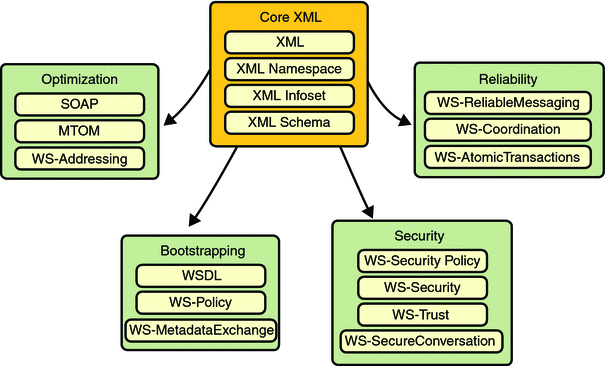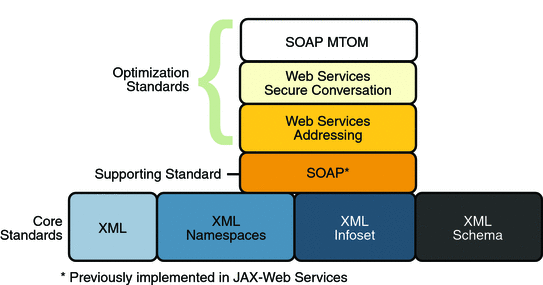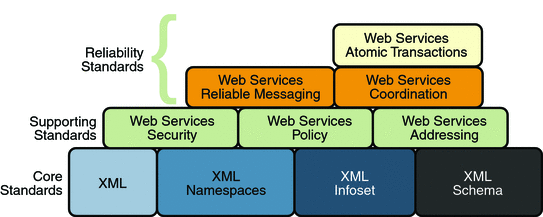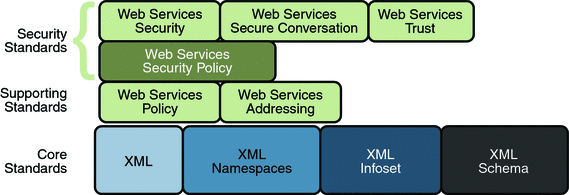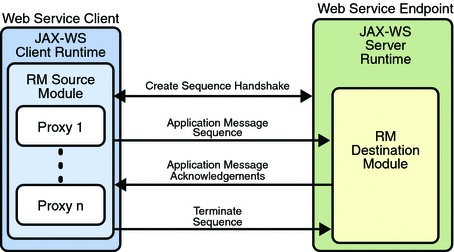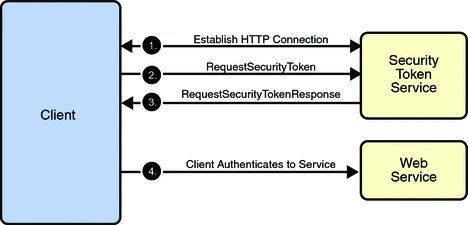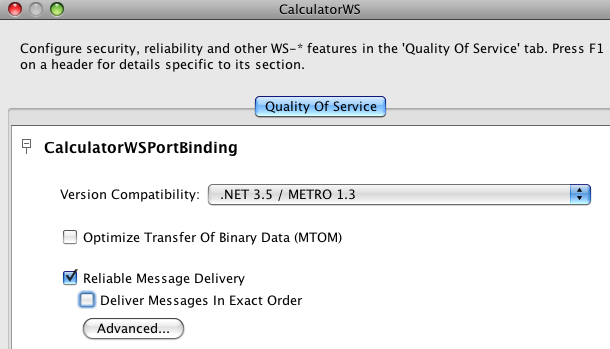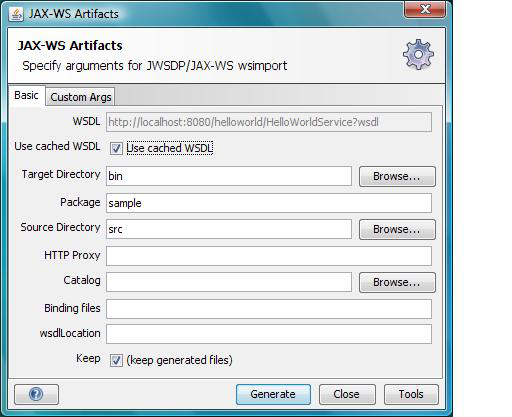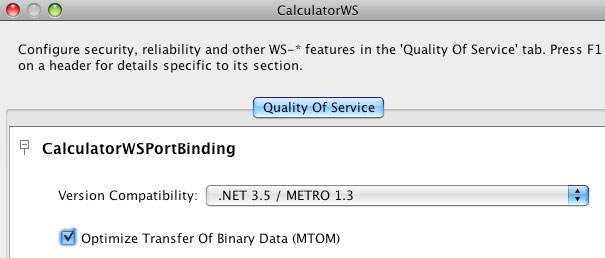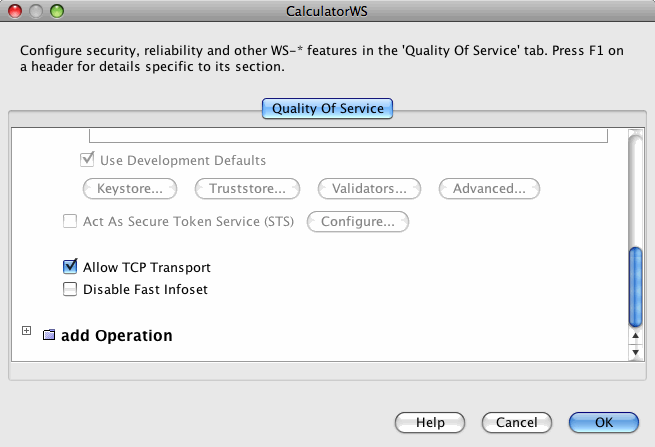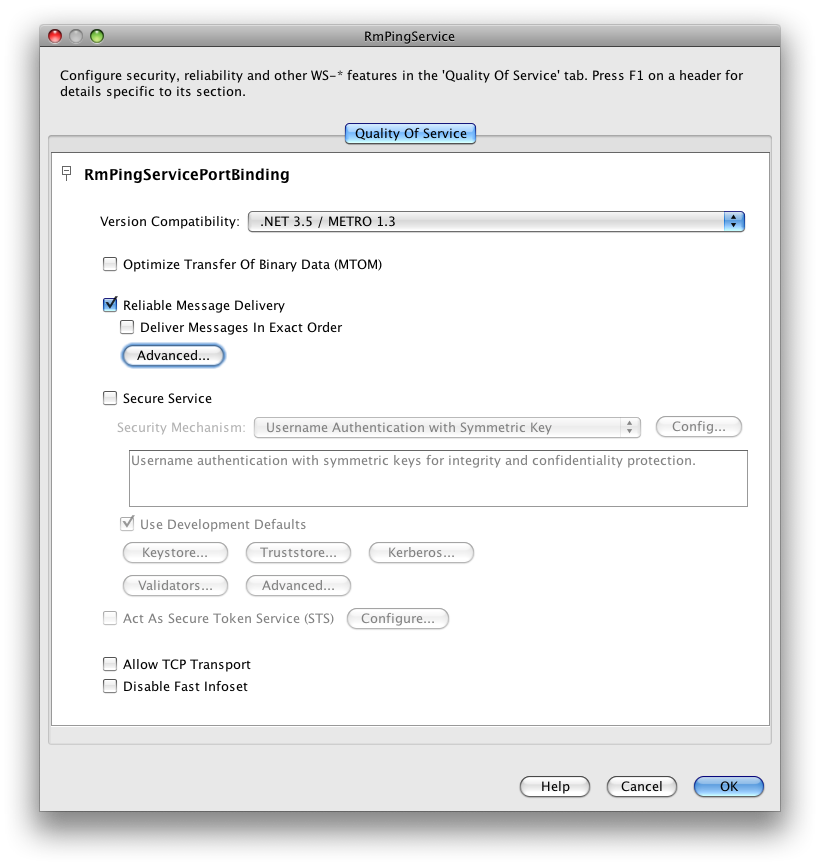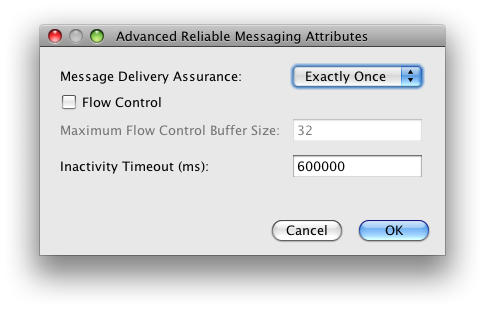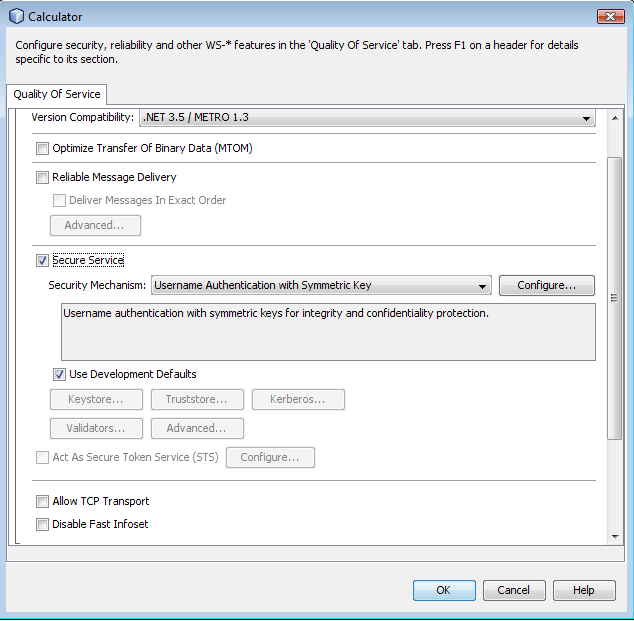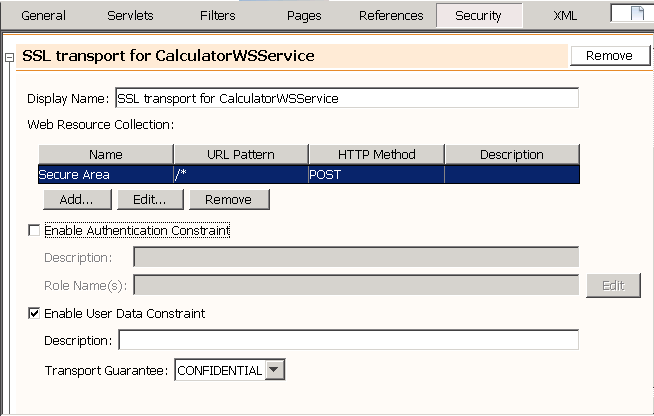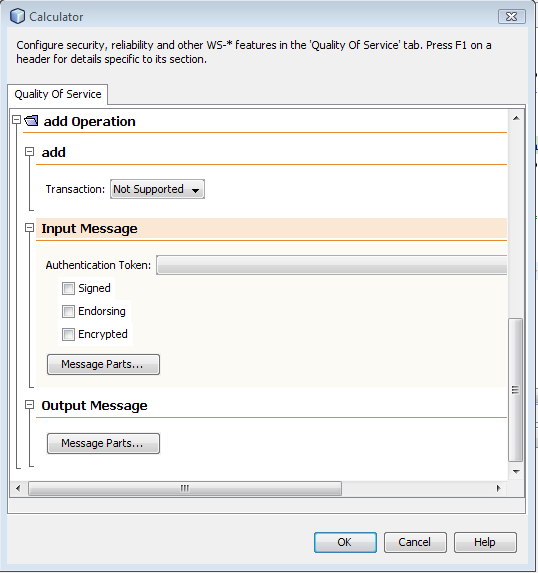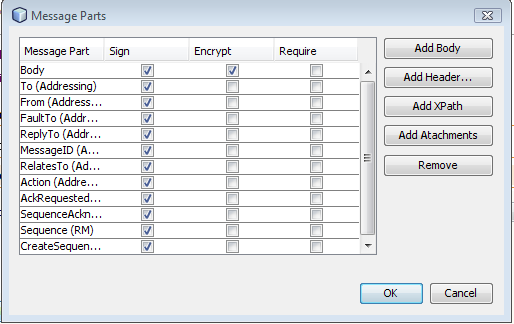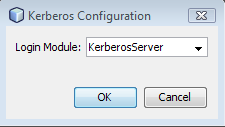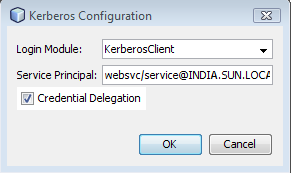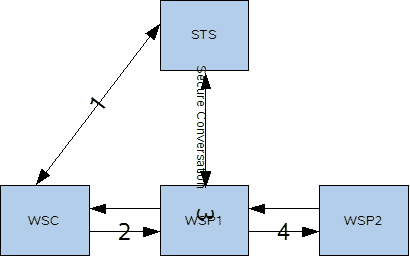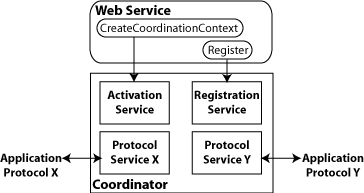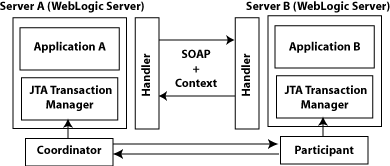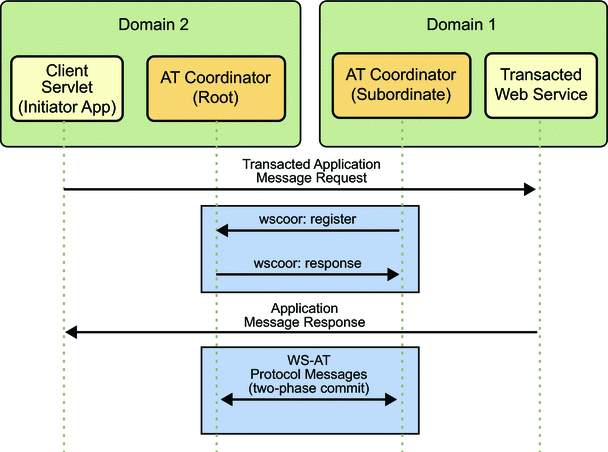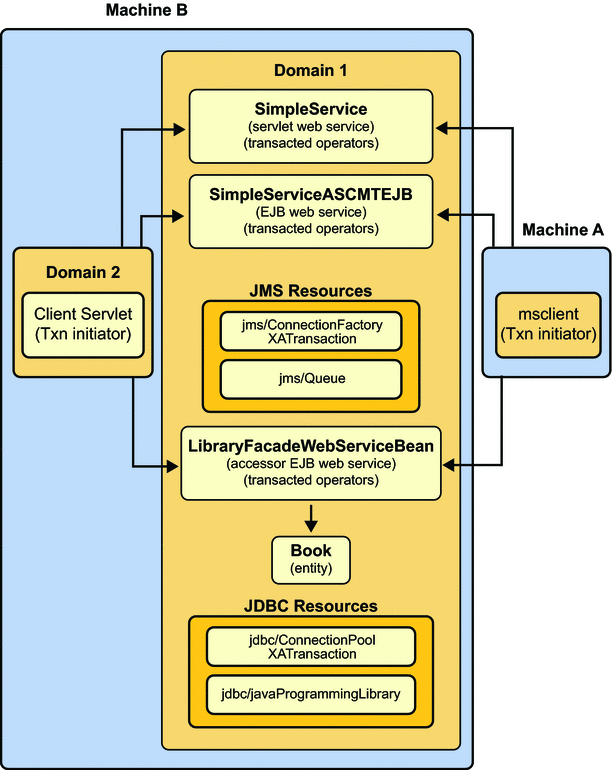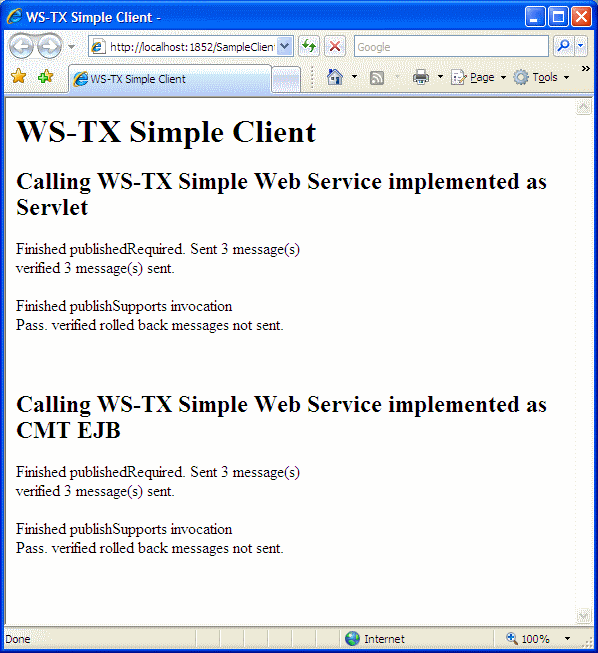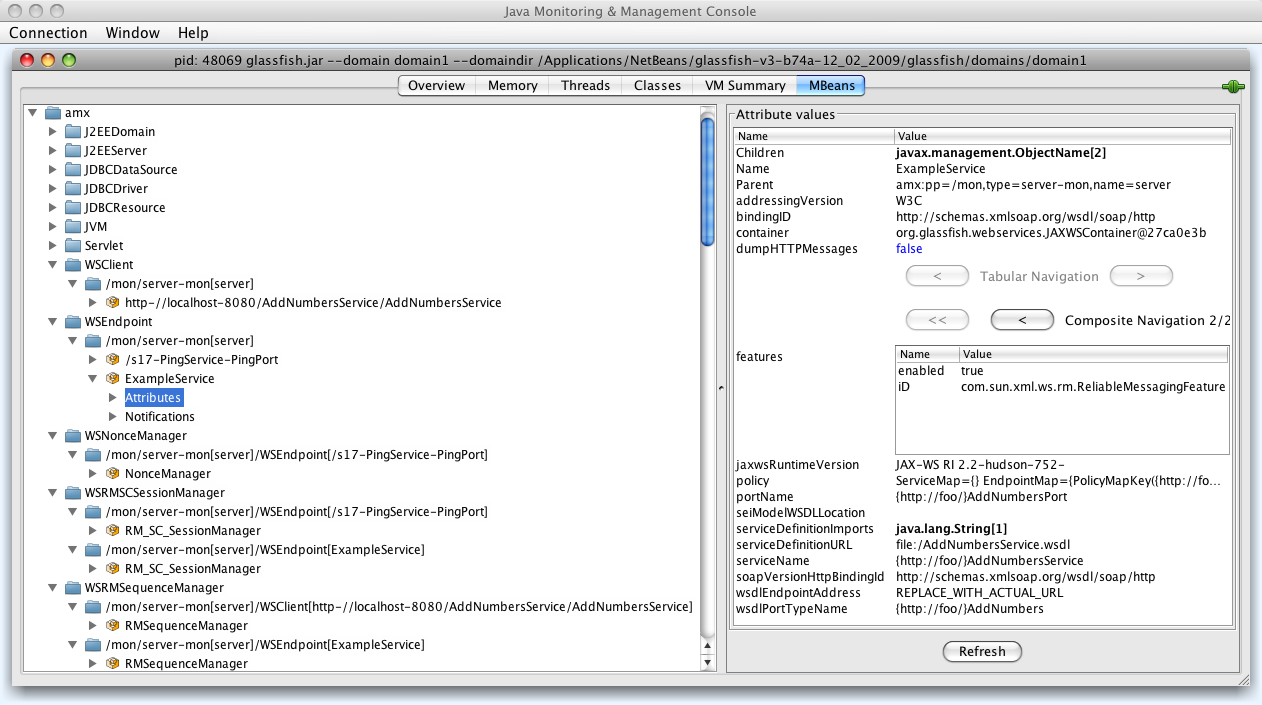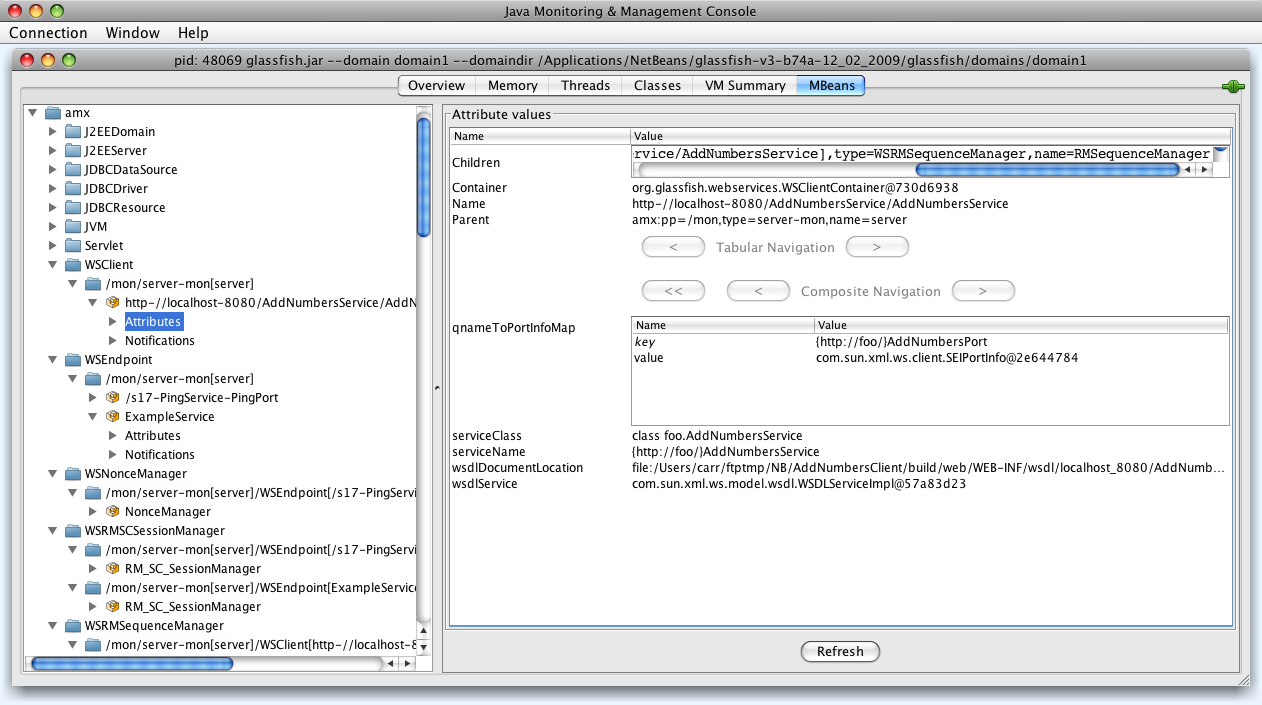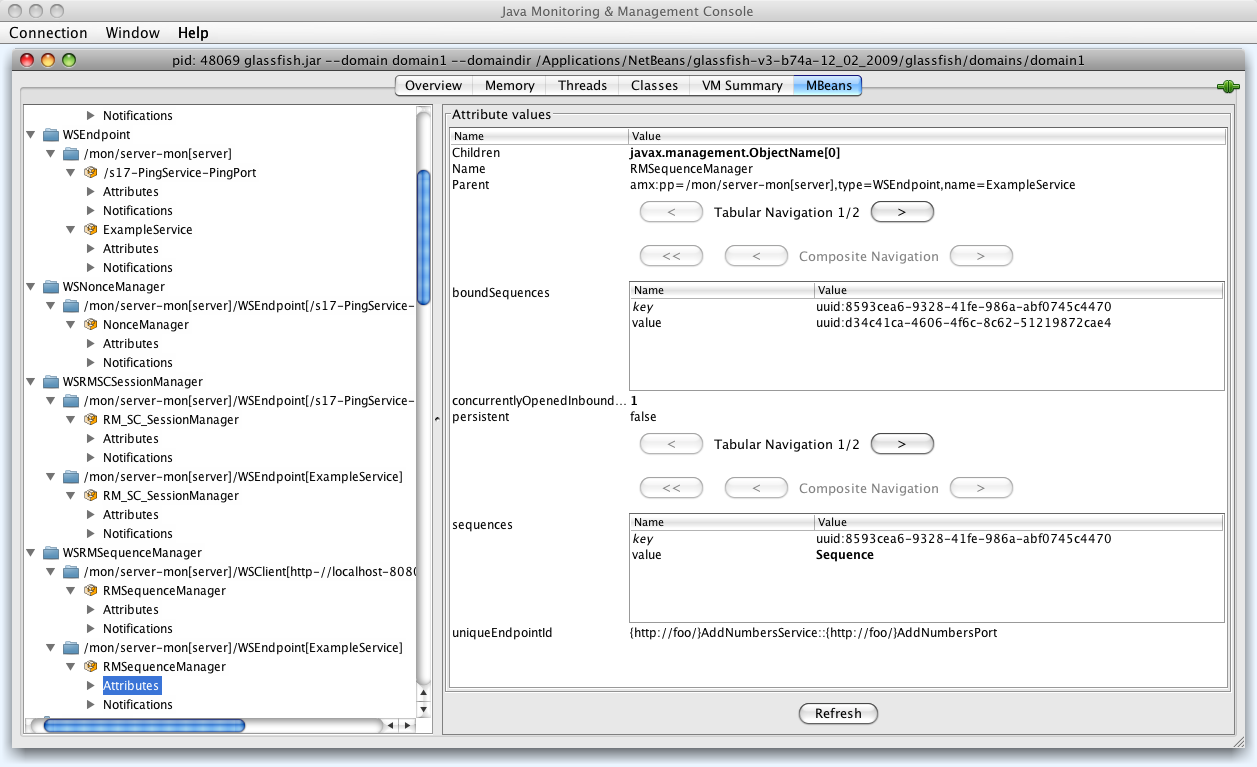12.3. Security Mechanisms
This section describes security mechanisms you can implement
with WSIT. This section provides an overview of the following
mechanisms:
A table that summarizes the configuration options on the server
side is available in Summary of Service-Side Configuration Requirements.
Some common communication issues that need to be addressed using
security mechanisms are discussed in Using Security Mechanisms.
12.3.1. Username Authentication with Symmetric Key
The Username Authentication with Symmetric Key mechanism
protects your application for integrity and confidentiality.
Symmetric key cryptography relies on a single, shared secret key
that is used to both sign and encrypt a message. Symmetric keys
are usually faster than public key cryptography.
For this mechanism, the client does not possess any
certificate/key of his own, but instead sends its
username/password for authentication. The client shares a secret
key with the server. The shared, symmetric key is generated at
runtime and encrypted using the service's certificate. The client
must specify the alias in the truststore by identifying the
server's certificate alias.
See Also: Example: Username Authentication with Symmetric Key
(UA).
12.3.2. Username Authentication with Password Derived Keys
This feature is same as "Username Authentication with
Symmetric Key", except that the protection token is Username
Token.This feature relies on a single, shared secret key that is
derived using password, salt(a 16 byte random array),iterations(an
int value).This key will be used for signing and encrypting a
message.
For this mechanism, the client does not need to have any
certificate/key of his own.A 160 bit secret key will be generated
using password,salt and iterations. This secret key will be used
for signature/encryption. In the request the username,salt and
iterations will be send to the server.The server generates the
same key using the password(which it already has),salt and
iterations. Using this key the server is able to decrypt the
message and verify the signature.The default value for iterations
is 1000.Current Netbeans versions doesn't show this feature in the
security features list.So for a detailed explanation about this
feature and to know how to configure this , please visit the blog:
http://blogs.sun.com/SureshMandalapu/entry/passwordderivedkeys_support_in_metro
12.3.3. Mutual Certificates Security
The Mutual Certificates Security mechanism adds security
through authentication and message protection that ensures
integrity and confidentiality. When using mutual certificates, a
keystore and truststore file must be configured for both the
client and server sides of the application.
See Also: Example: Mutual Certificates Security (MCS).
12.3.4. Symmetric Binding with Kerberos Tokens
Symmetric Binding with Kerberos Tokens does client
authentication using Kerberos Tokens and integrity and
confidentiality protection using symmetric keys generated with
Kerberos V5 Protocol. This profile assumes that Kerberos
authentication is supported by the underlying platform and a KDC
is configured. When using Kerberos Tokens Profile, a Login Module
must be configured for the service, and a Login Module and Service
Principal must be specified for the client.
Note
Kerberos is supported in Metro since 1.1 release.
Netbeans support is available for Kerberos from Metro 1.3
and Netbeans 6.5 release. Kerberos is NOT supported on AIX
systems.
See Also: Example: Kerberos Token (Kerb).
12.3.5. Transport Security (SSL)
The Transport Security mechanism protects your application
during transport using SSL for authentication and confidentiality.
Transport-layer security is provided by the transport mechanisms
used to transmit information over the wire between clients and
providers, thus transport-layer security relies on secure HTTP
transport (HTTPS) using Secure Sockets Layer (SSL). Transport
security is a point-to-point security mechanism that can be used
for authentication, message integrity, and confidentiality. When
running over an SSL-protected session, the server and client can
authenticate one another and negotiate an encryption algorithm and
cryptographic keys before the application protocol transmits or
receives its first byte of data. Security is "live" from the time
it leaves the consumer until it arrives at the provider, or vice
versa. The problem is that it is not protected once it gets to its
destination. For protection of data after it reaches its
destination, use one of the security mechanisms that uses SSL and
also secures data at the message level.
Digital certificates are necessary when running secure HTTP
transport (HTTPS) using Secure Sockets Layer (SSL). The HTTPS
service of most web servers will not run unless a digital
certificate has been installed. Digital certificates have already
been created for GlassFish, and the default certificates are
sufficient for running this mechanism, and are required when using
Atomic Transactions (see Using Atomic Transactions ). However, the message security
mechanisms require a newer version of certificates than is
available with GlassFish. You can download valid keystore and
truststore files for the client and server as described in To Manually Update GlassFish Certificates.
To use this mechanism, follow the steps in Configuring SSL For Your Applications.
See Also: Example: Transport Security (SSL).
12.3.5.1. Transport Security (SSL) Workaround
This note applies to cases where https is
the transport protocol used between a WSIT client and a secure
web service using transport binding, and you are referencing
localhost when creating the client.
Note
If you use the fully-qualified hostname (FQHN) in
the URL for the service WSDL when you are adding the web
service client to the client application, this workaround
is not required. It is only required when you specify
localhost in the URL for the service
WSDL.
During development (not production)
it is sometimes convenient to use certificates whose CN
(Common Name) does not match the host
name in the URL.
A developer would want to use a CN which is different
from the host name in the URL in WSIT when using
https addresses in Dispatch clients and during
wsimport . The below mentioned workaround is only
for the Dispatch clients, which are also used in WS-Trust to
communicate with STS. This has to be done even if the client's
main service is not on https, but only the STS is on
https.
Java by default verifies that the certificate CN (Common
Name) is the same as host name in the URL. If the CN in the
certificate is not the same as the host name, your web service
client fails with the following exception:
Example 12.2.
jakarta.xml.ws.WebServiceException: java.io.IOException:
HTTPS hostname wrong: should be <hostname as in the certificate>
The recommended way to overcome this issue is to
generate the server certificate with the Common Name (CN)
matching the host name.
To work around this only during development, in your
client code, you can set the default host name verifier to a
custom host name verifier which does a custom check. An
example is given below. It is sometimes necessary to include
this in the static block of your main Java class as shown
below to set this verifier before any connections are made to
the server.
Example 12.3.
static {
//WORKAROUND. TO BE REMOVED.
javax.net.ssl.HttpsURLConnection.setDefaultHostnameVerifier(
new javax.net.ssl.HostnameVerifier(){
public boolean verify(String hostname,
javax.net.ssl.SSLSession sslSession) {
if (hostname.equals("mytargethostname")) {
return true;
}
return false;
}
});
} Please remember to remove this code once you install
valid certificates on the server.
12.3.6. Message Authentication over SSL
The Message Authentication over SSL mechanism attaches a
cryptographically secured identity or authentication token with
the message and use SSL for confidentiality protection.
By default, a Username Supporting Token will be used for
message authentication. To use an X.509 Supporting Token instead,
click the Configure button and select X509. Under this scenario,
you will need to configure your system for using SSL as described
in Configuring SSL For Your Applications.
12.3.7. SAML Authorization over SSL
The SAML Authorization over SSL mechanism attaches an
authorization token with the message and uses SSL for
confidentiality protection. In this mechanism, the SAML token is
expected to carry some authorization information about an end
user. The sender of the token is actually vouching for the
credentials in the SAML token.
To use this mechanism, configure SSL on the server, as
described in Configuring SSL For Your Applications,
and, on the clients side, configure a SAMLCallbackHandler as
described in Example SAML Callback Handlers.
See Also: Example: SAML Authorization over SSL (SA).
12.3.8. Endorsing Certificate
This mechanism uses secure messages using symmetric key for
integrity and confidentiality protection, and uses an endorsing
client certificate to augment the claims provided by the token
associated with the message signature. For this mechanism, the
client knows the service's certificate, and requests need to be
endorsed/authorized by a special identity. For example, all
requests to a vendor must be endorsed by a purchase manager, so
the certificate of the purchase manager should be used to endorse
(or counter sign) the original request.
12.3.9. SAML Sender Vouches with Certificates
This mechanism protects messages with mutual certificates
for integrity and confidentiality and with a Sender Vouches SAML
token for authorization. The Sender Vouches method establishes the
correspondence between a SOAP message and the SAML assertions
added to the SOAP message. The attesting entity provides the
confirmation evidence that will be used to establish the
correspondence between the subject of the SAML subject statements
(in SAML assertions) and SOAP message content. The attesting
entity, presumed to be different from the subject, vouches for the
verification of the subject. The receiver has an existing trust
relationship with the attesting entity. The attesting entity
protects the assertions (containing the subject statements) in
combination with the message content against modification by
another party. For more information about the Sender Vouches
method, read the SAML Token Profile document at http://docs.oasis-open.org/wss/oasis-wss-saml-token-profile-1.0.pdf
.
For this mechanism, the SAML token is included as part of
the message signature as an authorization token and is sent only
to the recipient. The message payload needs to be signed and
encrypted. The requestor is vouching for the credentials (present
in the SAML assertion) of the entity on behalf of which the
requestor is acting.
The initiator token, which is an X.509 token, is used for
signature. The recipient token, which is also an X.509 token, is
used for encryption. For the server, this is reversed, the
recipient token is the signature token and the initiator token is
the encryption token. A SAML token is used for
authorization.
See Also: Example: SAML Sender Vouches with Certificates (SV).
12.3.10. SAML Holder of Key
This mechanism protects messages with a signed SAML
assertion (issued by a trusted authority) carrying client public
key and authorization information with integrity and
confidentiality protection using mutual certificates. The
Holder-of-Key (HOK) method establishes the correspondence between
a SOAP message and the SAML assertions added to the SOAP message.
The attesting entity includes a signature that can be verified
with the key information in the confirmation method of the subject
statements of the SAML assertion referenced for key info for the
signature. For more information about the Holder of Key method,
read the SAML Token Profile document at http://docs.oasis-open.org/wss/oasis-wss-saml-token-profile-1.0.pdf
.
Under this scenario, the service does not trust the client
directly, but requires the client to send a SAML assertion issued
by a particular SAML authority. The client knows the recipient's
public key, but does not share a direct trust relationship with
the recipient. The recipient has a trust relationship with the
authority that issues the SAML token. The request is signed with
the client's private key and encrypted with the server
certificate. The response is signed using the server's private key
and encrypted using the key provided within the HOK SAML
assertion.
12.3.11. STS Issued Token
This security mechanism protects messages using a token
issued by a trusted Secure Token Service (STS) for message
integrity and confidentiality protection.
An STS is a service that implements the protocol defined in
the WS-Trust specification (you can find a link to this
specification at https://eclipse-ee4j.github.io/metro-wsit ).
This protocol defines message formats and message exchange
patterns for issuing, renewing, canceling, and validating security
tokens.
Service providers and consumers are in potentially different
managed environments but use a single STS to establish a chain of
trust. The service does not trust the client directly, but instead
trusts tokens issued by a designated STS. In other words, the STS
is taking on the role of a second service with which the client
has to securely authenticate. The issued tokens contain a key,
which is encrypted for the server and which is used for deriving
new keys for signing and encrypting.
To use this mechanism for the web service, you simply select
this option as your security mechanism. However, you must have a
Security Token Service that can be referenced by the service. An
example of an STS can be found in the section To Create and Secure the STS (STS) . In this section, you
select a security mechanism for the STS. The security
configuration for the client-side of this application is dependent
upon the security mechanism selected for the STS, and not on the
security mechanism selected for the application. The client
truststore must contain the certificate of the STS, which has the
alias of wssip if you are using the updated GlassFish
certificates.
See Also: Example: STS Issued Token (STS).
12.3.12. STS Issued Token with Service Certificate
This security mechanism is similar to the one discussed in
STS Issued Token , with the
difference being that in addition to the service requiring the
client to authenticate using a SAML token issued by a designated
STS, confidentiality protection is achieved using a service
certificate. A service certificate is Unhandled tag caution used
by a client to authenticate the service and provide message
protection. For GlassFish, a default certificate of
s1as is installed.
To use this mechanism for the web service, you simply select
this option as your security mechanism. However, you must have a
Security Token Service that can be referenced by the service. An
example of an STS can be found in the section To Create and Secure the STS (STS) . In this section, you
select a security mechanism for the STS. The security
configuration for the client-side of this application is dependent
upon the security mechanism selected for the STS, and not on the
security mechanism selected for the application. The client
truststore must contain the certificate of the STS, which has the
alias of wssip if you are using the updated GlassFish
certificates.
12.3.13. STS Issued Endorsing Token
This security mechanism is similar to the one discussed in
STS Issued Token , with the
difference being that the client authenticates using a SAML token
that is issued by a designated STS. An endorsing token is used to
sign the message signature.
In this mechanism, message integrity and confidentiality are
protected using ephemeral keys encrypted for the service.
Ephemeral keys use an algorithm where the exchange key value is
purged from the cryptographic service provider (CSP) when the key
handle is destroyed. The service requires messages to be endorsed
by a SAML token issued by a designated STS.
Service providers and consumers are in potentially different
managed environments. For this mechanism, the service requires
that secure communications be endorsed by a trusted STS. The
service does not trust the client directly, but instead trusts
tokens issued by a designated STS. In other words, the STS is
taking on the role of a second service with which the client has
to securely authenticate.
For this mechanism, authentication of the client is achieved
in this way:
The client authenticates with the STS and obtains
the necessary token with credentials.
The client's request is signed and encrypted using
ephemeral key K.
The server's response is signed and encrypted using
the same K.
The primary signature of the request is endorsed
using the issued token.
To use this mechanism for the web service, you simply select
this option as your security mechanism. However, you must have a
Security Token Service that can be referenced by the service. An
example of an STS can be found in the section To Create and Secure the STS (STS) . In this section, you
select a security mechanism for the STS. The security
configuration for the client-side of this application is dependent
upon the security mechanism selected for the STS, and not on the
security mechanism selected for the application. The client
truststore must contain the certificate of the STS, which has the
alias of wssip if you are using the updated GlassFish
certificates.
12.5. Configuring Keystores and Truststores
This section describes configuring keystores and truststores.
Security mechanisms that use certificates require keystore and
truststore files for deployment.
For GlassFish, default keystore and truststore files
come bundled. However, WSIT security mechanisms for
message security require X.509 version 3
certificates. GlassFish contains version 1 certificates.
Therefore, to enable the WSIT applications to run on
GlassFish, you will need to follow the instructions in To Manually Update GlassFish Certificates .
For Tomcat, keystore and truststore files do not come
bundled with this container, so they must be provided. You can
download valid keystore and truststore files for the client
and server from http://xwss.java.net/
.
This section covers the following topics:
To Automatically Update GlassFish Certificates
You can have NetBeans automatically update the GlassFish
certificates to the version needed to work with message
security. To do this, follow these steps:
In NetBeans IDE, right-click
the web service, select Edit Web Service Attributes.
Select Secure
Service.
Select Use Development
Defaults.
This option imports certificates into the GlassFish
keystore and truststore so that they can be used
immediately for development.
In a production environment, you should provide your
own certificates and user settings, however, in a
development environment you may find these defaults
useful.
To Manually Update GlassFish Certificates
The WSIT message security mechanisms require the use of
v3 certificates. The default GlassFish keystore and truststore
Unhandled tag varname do not contain v3 certificates at this
time (but should before FCS). (GlassFish instances installed
using JDK 1.6 do have a v3 certificate but the certificate
lacks a particular extension required for supporting some
secure WSIT mechanisms.) In order to use message security
mechanisms with GlassFish, it is necessary to download
keystore and truststore files that contain v3 certificates and
import the appropriate certificates into the default GlassFish
stores.
Note
The XWSS keystores are sample
keystores containing sample v3 certificates. These sample
keystores can be used for development and testing of
security with WSIT technology. Once an application is in
production, you should definitely use your own v3
certificates issued by a trusted authority. In order to
use WSIT security on GlassFish, you will have to import
your trusted stores into GlassFish's keystore and specify
those certificates from NetBeans IDE.
To manually update the GlassFish certificates, follow
these steps.
Download the zip file that
contains the certificates and the Ant scripts (
copyv3.zip ) by going to this URL:
https://xwss.java.net/servlets/ProjectDocumentList?folderID=6645&expandFolder=6645&folderID=6645
Unzip this file and change
into its directory, copyv3 .
Set the variable to the
location where GlassFish is installed, as described in the
README.txt file in this directory.
From the copyv3
directory, execute the Ant command that will copy the
keystore and truststore files to the appropriate location,
and import the appropriate certificates into the GlassFish
keystore and truststore.
This Ant command is as follows:
as-install/lib/ant/bin/ant
The command window will echo back the certificates
that are being added to the keystore and truststore files,
and should look something like this:
[echo] WARNING: currently we add non-CA certs to GF truststore, this
will not be required in later releases when WSIT starts supporting CertStore(s)
[java] Added Key Entry :xws-security-server
[java] Added Key Entry :xws-security-client
[java] Added Trusted Entry :xwss-certificate-authority
[java] Added Key Entry :wssip
[java] Added Trusted Entry :xws-security-client
[java] Added Trusted Entry :xws-security-server
[java] Added Trusted Entry :wssip
[echo] Adding JVM Option for https outbound alias, this will take at least
One Minute.
...
To verify that the updates
were successful, follow these steps:
Change to the directory
containing the GlassFish keystore and truststore
files, as-install /domains/domain1/config
.
Verify that the v3
certificate has been imported into the GlassFish
truststore. To do this, run the following
keytool command (all on one line):
java-home/bin/keytool -list -keystore cacerts.jks -alias wssip -storepass changeit
If the certificates are
successfully updated, your
response will look something like this:
wssip, Aug 20, 2007, trustedCertEntry,
Certificate fingerprint (MD5): 1A:0E:E9:69:7D:D0:80:AD:5C:85:47:91:EB:0D:11:B1
If the certificates were
not successfully update, your
response will look something like this:
keytool error: java.lang.Exception: Alias <wssip> does not exist
Verify that the v3
certificate has been imported into the GlassFish
keystore. To do this, run the following
keytool commands:
java-home/bin/keytool -list -keystore keystore.jks
-alias xws-security-server -storepass changeit
java-home/bin/keytool -list -keystore keystore.jks
-alias xws-security-client -storepass changeit
If the certificates were
successfully updated, your
response should look something like this:
xws-security-server, Aug 20, 2007, PrivateKeyEntry,
Certificate fingerprint (MD5): E4:E3:A9:02:3C:B0:36:0C:C1:48:6E:0E:3E:5C:5E:84
If your certificates were
not successfully updated, your
response will look more like this:
keytool error: java.lang.Exception: Alias <xws-security-server> does not exist
12.5.1. Specifying Aliases with the Updated Stores
The configuration of the aliases for all containers (Tomcat,
GlassFish) and for all applications (JSR-109-compliant and
non-JSR-109-compliant), except for applications that use a
Security Token Service (STS) mechanism, is as shown in Keystore and Truststore Aliases .
Table 12.3. Keystore and Truststore Aliases
|
| Keystore Alias | Truststore Alias |
|---|
Client-Side
Configuration | xws-security-client | xws-security-server |
Server-Side
Configuration | xws-security-server | xws-security-client |
The configuration of the aliases for applications that use a
Security Token Service (STS) mechanism is as shown in Keystore and Truststore Aliases for STS .
Table 12.4. Keystore and Truststore Aliases for STS
|
| Keystore Alias | Truststore Alias |
|---|
Client-Side
Configuration | xws-security-client | xws-security-server |
STS Configuration | xws-security-client | wssip |
12.5.2. Configuring the Keystore and Truststore
NetBeans IDE already knows the location of the default
keystore file and its password, but you need to specify which
alias is to be used. The following sections discuss configuring
the keystore on the service and on the client.
To Configure the Keystore on a Service
Automatically
To have NetBeans IDE configure the keystore to its
default values, follow these steps.
In NetBeans IDE,
right-click the web service, select Edit Web Service
Attributes.
Select Secure
Service.
Select Use Development
Defaults.
This option imports certificates into the
GlassFish keystore and truststore so that they can be
used immediately for development. This option also
inserts the location and alias of the keystore and
truststore files into the configuration file.
In a production environment, you should provide
your own certificates and user settings, however, in a
development environment you may find these defaults
useful.
To Configure the Keystore on a Service Manually
A keystore is a database of private keys and their
associated X.509 certificate chains authenticating the
corresponding public keys. A key is a piece of information
that controls the operation of a cryptographic algorithm.
For example, in encryption, a key specifies the particular
transformation of plaintext into ciphertext, or vice versa
during decryption. Keys are used in digital signatures for
authentication.
To configure a keystore on a service, perform the
following steps.
Check the table in Summary of Service-Side Configuration Requirements to see if
a keystore needs to be configured for the selected
security mechanism. If so, continue.
Right-click the web
service and select Edit Web Service Attributes.
The Web Service Attributes editor is
displayed.
Enable Secure Service,
then select a security mechanism.
Check the table in Summary of Service-Side Configuration Requirements to see
what keystore configuration, if any, is required for
that mechanism.
Unselect Use Development
Defaults.
Click the Keystore
button. The dialog shown in Keystore Configuration Dialog displays.
Depending on what is
required for the selected mechanism, you may specify
the following information in the Keystore
Configuration dialog:
Keystore Password :
Specifies the password for the keystore file. If you
are running under GlassFish, GlassFish's password is
already entered. If you have changed the keystore's
password from the default, you must specify the
correct value in this field.
Load Aliases : Click the
Load Aliases button to populate the Alias field with
the aliases contained in the keystore file. The
Location and Store Password fields must be specified
correctly for this option to work.
Alias : Specifies the
alias of the certificate in the specified keystore
to be used for authentication. Refer to the table in
Specifying Aliases with the Updated Stores to
determine which alias to choose for the selected
security mechanism.
Key Password : Specifies
the password of the key within the keystore. For
this sample, leave this blank. For this field, the
default assumes the key password is the same as the
store password, so you only need to specify this
field when the key password is different.
Note
The Key Password field enables you to specify
a password for the keystore used by the application.
When specified, this password is stored in a WSIT
configuration file in clear text, which is a
security risk. Setting the keystore password in the
development environment is fine, however, when you
go into production, remember to use the container's
Callback Handler to obtain the keys from the
keystore. This eliminates the need for the keystore
passwords to be supplied by the users. You can also
specify the passwords for keystores and truststores
by specifying a Callback Handler class that
implements the
javax.security.auth.callback.CallbackHandler
interface in the Key Password or Store Password
fields.
When creating JSR-109-compliant application,
GlassFish will only use the default CallbackHandlers
and Validators, and you cannot override the location
of the keystore and truststore files. Any attempt to
override the default location will be ignored. You do,
however, need to specify the keystore and truststore
locations in these dialogs in order to specify the
alias.
When creating non-JSR-109-compliant application,
you can specify the passwords for keystores and
truststores by specifying a
CallbackHandler class that implements the
javax.security.auth.callback.CallbackHandler
interface in the Key Password or Store Password
fields.
Click OK to close the
dialog.
To Configure the Truststore on a Service
Automatically
To have NetBeans IDE configure the truststore to its
default values, follow these steps.
In NetBeans IDE,
right-click the web service, select Edit Web Service
Attributes.
Select Secure
Service.
Select Use Development
Defaults.
This option imports certificates into the
GlassFish keystore and truststore so that they can be
used immediately for development. This option also
inserts the location and alias of the keystore and
truststore files into the configuration file, when
required for a selected security mechanism.
In a production environment, you should provide
your own certificates and user settings, however, in a
development environment you may find these defaults
useful.
To Configure the Truststore on a Service
Manually
A truststore is a database of trusted entities and
their associated X.509 certificate chains authenticating
the corresponding public keys.
The truststore contains the Certificate Authority
(CA) certificates and the certificates of the other party
to which this entity intends to send encrypted
(confidential) data. This file must contain the public key
certificates of the CA and the client's public key
certificate. Any kind of encryption without
WS-SecureConversation will generally require that a
truststore be configured on the client side. Any kind of
signature without WS-SecureConversation will generally
require a truststore on the server side.
Note
For this release, place the trusted certificates
of other parties in GlassFish's truststore,
cacerts.jks . This is not normally a
recommended practice because any certificate you add
to the cacerts.jks file effectively means
it can be a trusted root for any and all certificate
chains, which can be a security problem. In future
releases, trusted certificates from other parties will
be placed in a certstore, and only trusted roots will
be placed inside cacerts.jks .
To set the truststore configuration options on a
service, perform the following steps.
Check the table in Summary of Service-Side Configuration Requirements to see if
a truststore is required for the selected security
mechanism. If so, continue.
Right-click the web
service and select Edit Web Service Attributes.
The Web Service Attributes editor is
displayed.
Enable Secure
Service.
Unselect Use Development
Defaults.
Click the Truststore
button.
On the Truststore
Configuration page, specify the following options:
Location : By default,
the location and name of the truststore that stores
the public key certificates of the CA and the
client's public key certificate is already entered.
The GlassFish truststore file is as-install
/domains/domain1/config/cacerts.jks.
Store Password :
Specifies the password for the truststore. If you
are using GlassFish, the value of
changeit is already entered. If you
have changed the value of the truststore password,
you must type the new value in this field.
Note
The Store Password field enables you to
specify a password for the truststore used by the
application. When specified, this password is stored
in a WSIT configuration file in clear text, which is
a security risk. Setting the truststore password in
the development environment is fine, however, when
you go into production, remember to use the
container's Callback Handler to obtain the keys from
the truststore. This eliminates the need for the
truststore passwords to be supplied by the users.
You can also specify the passwords for keystores and
truststores by specifying a CallbackHandler class
that implements the
javax.security.auth.callback.CallbackHandler
interface in the Key Password or Store Password
fields.
When creating JSR-109-compliant application,
GlassFish will only use the default CallbackHandlers
and Validators, and you cannot override the location
of the keystore and truststore files. Any attempt to
override the default location will be ignored. You
do, however, need to specify the keystore and
truststore locations in these dialogs in order to
specify the alias.
Load Aliases : Click the
Load Aliases button to populate the Alias field with
the aliases contained in the truststore file. The
Location and Store Password fields must be specified
correctly for this option to work.
Alias : Unhandled tag tip
Specifies the peer alias of the certificate in the
truststore that is to be used when the client needs
to send encrypted data. Refer to the table in Specifying Aliases with the Updated Stores to
determine which alias is appropriate for the
selected security mechanism. A truststore contains
trusted other-party certificates and certificates of
Certificate Authorities (CA). A peer alias is the
alias of the other party (peer) that the sending
party needs to use to encrypt the request.
Click OK to close the
dialog.
To Configure the Keystore and Truststore on a
Client
On the client side, a keystore and truststore file
must be configured for some of the security mechanisms.
Refer to the table in Summary of Client-Side Configuration Requirements for information on which
mechanisms require the configuration of keystores and
truststores.
If the mechanism configured for the service requires
the configuration of keystores and truststores, follow
these steps.
Check the table in Summary of Client-Side Configuration Requirements to see if
a keystore needs to be configured for the client for
the selected security mechanism. If so, continue.
In the Projects window,
expand the node for the web service client.
Expand the Web Service
References node.
Right-click the node for
the web service reference for which you want to
configure security options.
Select Edit Web Service
Attributes.
When the Web Service References Attributes
Editor is opened, select the Quality of Service tab to
display the WSIT Security options.
Click Keystore or
Truststore to specify the keystore or truststore
information if required by the service.
Depending on what is
required for the selected mechanism, you may specify
the following information:
Keystore Location : The
directory and file name containing the certificate
key to be used to authenticate the client. By
default, the location is already set to the default
GlassFish keystore, as-install
/domains/domain1/config/keystore.jks
.
Keystore Password : The
password for the keystore used by the client. By
default, the password for the GlassFish keystore is
already entered. This password is
changeit .
Note
When specified, this password is stored in a
WSIT configuration file in clear text. Setting the
keystore password in the development environment is
fine, however, when you go into production, remember
to use the container's default
CallbackHandler to obtain the keys from
the keystore. This eliminates the need for the
keystore passwords to be supplied by the users. You
can also specify the passwords for keystores and
truststores by specifying a
CallbackHandler class that implements
the
javax.security.auth.callback.CallbackHandler
interface in the Keystore Password, Truststore
Password, or Key Password fields.
Load Aliases : Click this
button to populate the Alias list with all of the
certificates available in the selected keystore.
This option will only work if the keystore location
and password are correct.
Keystore Alias : Select
the alias in the keystore. Refer to the table in
Specifying Aliases with the Updated Stores to
determine which alias is appropriate for the
selected security mechanism.
Key Password : If the
client key has been password-protected, type the
password for this key. The GlassFish certificate key
password is changeit .
Truststore Location : The
directory and file name of the client truststore
containing the certificate of the server. By
default, this field points to the default GlassFish
truststore, as-install
/domains/domain1/config/cacerts.jks.
Truststore Password : The
password for the truststore used by the client. By
default, the password for the GlassFish truststore
is already specified. The password is
changeit .
Note
When specified, this password is stored in a
WSIT configuration file in clear text. Setting the
truststore password in the development environment
is fine; however, when you go into production,
remember to use the container's default
CallbackHandler to obtain the keys from
the keystore. This eliminates the need for the
keystore passwords to be supplied by the users. You
can also specify the passwords for keystores and
truststores by specifying a
CallbackHandler class that implements
the
javax.security.auth.callback.CallbackHandler
interface in the Keystore Password, Truststore
Password, or Key Password fields.
Load Aliases : Click this
button to populate the Alias list with all of the
certificates available in the selected keystore.
This option will only work if the truststore
location and password are correct.
Truststore Alias : Select
the alias of the server certificate and private key
in the client truststore. Refer to the table in
Specifying Aliases with the Updated Stores to
determine which alias is appropriate for the
selected security mechanism.
Click OK to close the
dialog.
12.5.3. Configuring Validators
A validator is an optional set of classes used to check the
validity of a token, a certificate, a timestamp, or a username and
password. The Validators button will be enabled when all of the
following are true:
Security is enabled for the service.
Target server for the service is not
GlassFish.
Development defaults are disabled.
Security profile for the service is not one of the
three STS based profiles.
Applications that run under a GlassFish 9.1 or higher
container do not need to configure Callback Handlers and
Validators when using the IDE with WSIT enabled. This is because
the container handles the callbacks and validation. You only need
to make sure that the certificates are available at locations that
GlassFish requires and/or create authorized users using the Admin
Console (described in Adding Users to GlassFish .
Validators are always optional because there are defaults in
the runtime (regardless of the container and regardless of whether
the application is a JSR-109 or a non-JSR-109 deployment.) For
non-JSR-109 deployment, you only need to specify a validator when
you want to override the default validators. For JSR-109
deployments, there is no point in specifying an overriding
validator, as these will be overridden back to the defaults by
GlassFish, thus the Validators button is not available when the
selected web service is a JSR-109-compliant application.
To Set Validator Configuration Options
To set the validator configuration options for a
non-JSR-109-compliant application (such as a Java SE client),
perform the following steps.
Right-click the web
service and select Edit Web Service Attributes.
The Web Service Attributes editor is
displayed.
Enable Secure
Service.
Unselect Use Development
Defaults.
Click the Validator
button.
On the Validator
Configuration page, specify the following options,
when necessary:
Username Validator :
Specifies the validator class to be used to validate
username and password on the server side. This
option is only used by a web service.
Note
When using the default Username Validator,
make sure that the username and password of the
client are registered with GlassFish (using Admin
Console, described in Adding Users to GlassFish ) if using GlassFish, or
is included in the tomcat-users.xml
file if using Tomcat.
Timestamp Validator :
Specifies the validator class to be used to check
the token timestamp to determine whether the token
has expired or is still valid.
Certificate Validator :
Specifies the validator class to be used to validate
the certificate supplied by the client or the web
service.
SAML Validator:
Specifies the validator class to be used to validate
SAML token supplied by the client or the web
service.
Click OK to close the
dialog.
12.6. Configuring Kerberos for GlassFish and Tomcat
This section explains how to setup GlassFish or Tomcat to use
Kerberos Authentication. It assumes that the underlying infrastructure
has Kerberos Authentication available. If you need information on how
to setup Kerberos in Solaris or Ubuntu Linux environments, refer to
the following links:
Note that in a Windows environment you can set up a Kerberos KDC
only on Window Server editions 2000, 2022 and 2008. The KDC is bundled
in these editions with its own Kerberos implementation as part of
Active Directory. You can not install MIT Kerberos KDC on Windows. A
Windows XP/Vista system can act as a client of the Windows Server
editions KDC. Alternatively, you can install a client module of MIT
Kerberos for Windows -- see Kerberos
for Windows Release 3.2.2.You can then use the client module to
authenticate against a KDC that was set up on a UNIX system.
Specify the JAAS login modules to be used for Kerberos in
the $GLASSFISH_HOME/domains/domain1/config/login.conf file, as
follows:
KerberosClient {
com.sun.security.auth.module.Krb5LoginModule required
useTicketCache=true;
}
KerberosServer {
com.sun.security.auth.module.Krb5LoginModule required
useKeyTab=true keyTab="/etc/krb5.keytab"
doNotPrompt=true storeKey=true
principal="websvc/service@INDIA.SUN.LOCAL";
}You can give any names to the login modules, that is,
instead of KerberosClient and KerberosServer. You need to refer to
these names in the <sc:KerberosConfig> assertion in the WSDL
file and in the wsit-client.xml file.
Also edit the principal in
KerberosServer to the
service_principal that you created, and
specify the correct location of krb5.keytab
file.
GlassFish picks the login modules from
$GLASSFISH_HOME/domains/domain1/config/login.conf. In Tomcat we
need to specify the file explicitly using
java.security.auth.login.config system property. Here are the
steps:
Create a file jaas.conf , and place it in
$CATALINA_HOME/conf. Here's what jaas.conf looks like:
KerberosClient {
com.sun.security.auth.module.Krb5LoginModule required
useTicketCache=true;
};
KerberosServer {
com.sun.security.auth.module.Krb5LoginModule required
useKeyTab=true keyTab="/etc/krb5.keytab"
doNotPrompt=true storeKey=true
principal="websvc/service@INDIA.SUN.COM";
};Add following line to the catalina.sh script (or
specify the mentioned JAVA_OPTS property):
JAVA_OPTS="$JAVA_OPTS "-Djava.security.auth.login.config=$CATALINA_HOME/conf/jaas.conf
Specify the following system property in your client
code:
-Djava.security.policy=${tomcat.home}/conf/catalina.policy
-Djava.security.auth.login.config=${tomcat.home}/conf/jaas.conf
12.8. Configuring A Secure Token Service (STS)
A Secure Token Service (STS) is a Web service that issues
security tokens. That is, it makes assertions based on evidence that
it trusts, to whoever trusts it (or to specific recipients). To
communicate trust, a service requires proof, such as a signature, to
prove knowledge of a security token or set of security tokens. A
service itself can generate tokens or it can rely on a separate STS to
issue a security token with its own trust statement (note that for
some security token formats this can just be a re-issuance or
co-signature). This forms the basis of trust brokering.
The issued token security model includes a target service, a
client, and a trusted third party called a Security Token Service
(STS). Policy flows from service to client, and from STS to client.
Policy may be embedded inside an issued token assertion, or acquired
out-of-hand. There must be an explicit trust relationship between the
service and the STS and the client and the STS. There does not need to
be a trust relationship between the client and service.
When the web service being referenced by the client uses any of
the STS security mechanisms (refer to tables in Summary of Service-Side Configuration Requirements and Summary of Client-Side Configuration Requirements ), an STS must be specified. You can
specify the STS in the following ways.
This section covers the following topics:
To Create a Third-Party STS
Use the STS wizard to create an STS. When using the STS
wizard, provide the name of the STS implementation class. This
class must extend
com.sun.xml.ws.security.trust.sts.BaseSTSImpl .
After completing the steps of the wizard, your application
will contain a new service that is an STS and includes a
provider implementation class, STS WSDL, and a WSIT
configuration file with a predefined set of policies.
To use the STS wizard to create an STS, follow these
steps.
Create a new project for the
STS by selecting File | New Project.
Select Java Web, then Web
Application, then Next.
Type a Project Name, then
Next, then the desired Server. Click
Finish.
Right-click the STS Project,
and select New, then select Other.
Select Web Services from the
Categories list.
Select Secure Token Service
(STS) from the File Type(s) list.
Click Next.
Type a name for the Web
Service Class Name.
Type or select a name for the
Package list.
Click
Finish.
The IDE takes a while to create the STS. When
created, it appears under the project's Web Services node
as your_STS Service ,
and the Java file appears in the right pane.
The STS wizard creates an
implementation of the provider class.
Back in the Projects window,
expand the STS project folder, expand the Web Services
node, right-click on the web service, and select Edit Web
Service Attributes to configure the STS.
Select the "Version
Compatibility" to ".NET 3.5 / Metro 1.3" ( e.g. see Web Service Attributes Editor Page ) . It will
use WS-SX version of all WS-* specifications.
Make sure Secure Service is
selected.
Select a Security Mechanism
that is NOT one of the STS mechanisms. The example
application uses Username Authentication with Symmetric
Key.
Select the Configure button.
For the Algorithm Suite option, specify a value that
matches the value of the web service. Set the Key Size to
128 if you have not configured Unlimited Strength
Encryption. Select OK to close the configuration dialog.
Note
Some of the algorithm suite settings require
that Unlimited Strength Encryption be configured in
the Java Runtime Environment (JRE), particularly the
algorithm suites that use 256 bit encryption.
Download the Java Cryptography Extension (JCE)
Unlimited Strength Jurisdiction Policy Files.
Installation instructions are provided in the JCE
zip file. You can download JCE from this URL: http://www.oracle.com/technetwork/java/javase/downloads/index.html
Make sure Act as Secure Token
Service (STS) is selected.
The default values will create a valid STS.
Optionally, you can change the following
configuration options by clicking the Configure
button:
Issuer : Specify an
identifier for the issuer for the issued token. This
value can be any string that uniquely identifies the
STS, for example, MySTS .
Contract Implementation
Class : Specify the actual implementation
class for the WSTrustContract interface
that will handle token issuance, validation, and the
like. Default value is
com.sun.xml.ws.security.trust.impl.WSTRustContractImpl
for issuing SAML assertions, or click Browse to
browse to another contract implementation
class.
Life Time of Issued
Tokens : The life span of the token
issued by the STS. Default value is 36,000
ms.
Encrypt Issued Key :
Select this option if the issued key should be
encrypted using the service certificate. Default is
true.
Encrypt Issued Token :
Select this option if the issued token should be
encrypted using the service certificate. Default is
false.
Optionally, to add one or more Service Providers
that have a trust relationship with the STS, click the Add
button, and specify the following configuration
options:
Provider Endpoint URI :
The endpoint URI of the service provider.
Certificate Alias : The
alias of the certificate of the service provider in
the keystore.
Token Type : The type of
token the service provider requires, for example,
urn:oasis:names:tc:SAML1.0:assertion
.
Key Type : The type of
key the service provider requires. The choices are
public key or symmetric key. Symmetric key
cryptography relies on a shared secret and is
usually faster than public key cryptography. Public
key cryptography relies on a key that is made public
to all and is primarily used for encryption but can
be used for verifying signatures.
Click OK to close the Select
STS Service Provider dialog, if open.
Click OK to close the STS
Configuration dialog, if open.
Click the Keystore button to
configure the keystore.
If you are using the GlassFish stores, click the
Load Aliases button and select wssip .
Otherwise, browse to the location of your keystore and
enter the relevant information.
Click OK to close the dialog.
Right-click the STS Project
and select Properties. Select the Run category, and type
the following in the Relative URL field: /
your_STS Service?wsdl .
Run the Project (right-click
the Project and select Run). The STS WSDL displays in a
browser window.
Check Building custom STS to
build a custom STS to control the user attributes to be included in
the SAML assertion.
Managing multiple services with Metro based STS
Metro based STS can be used to secure multiple services.
One need to register a service provider to an STS before the
issued tokens of the STS can be used for that service.
Each resgisted service comes up as a ServiceProvide in
the STSConfiguration:
Example 12.5.
<tc:STSConfiguration
xmlns:tc="http://schemas.sun.com/ws/2006/05/trust/server"
encryptIssuedKey="true" encryptIssuedToken="false">
<tc:LifeTime>36000</tc:LifeTime>
<tc:Contract>com.sun.xml.ws.security.trust.impl.WSTrustContractImpl
</tc:Contract>
<tc:Issuer>SunSTS</tc:Issuer>
<tc:ServiceProviders>
<tc:ServiceProvider endPoint="http://localhost:8080/jaxws-s5/simple">
<tc:CertAlias>bob</tc:CertAlias>
<tc:TokenType>
http://docs.oasis-open.org/wss/oasis-wss-saml-token-profile-1.1
#SAMLV1.1
</tc:TokenType>
</tc:ServiceProvider>
<!-- more service providers -->
</tc:ServiceProviders>
</tc:STSConfiguration>
At the minimum, you need to specify the endpoint as well
as the cert alias for each service provider. At run time, the
actual service is identified for each request RST from a
client to the STS. The RST contains an AppliesTo element
pointing to the endpoint of the targeted service. On the STS
side, the certificate of the service is used to encrypt the
issued tokens and proof keys for the service.
With Netbeans, one can add Service Providers to an STS
through the configuration panel for STS:
Click Configure button besides Act as Secure Token
Service (STS).
In the STS Configuration panel, click Add
In the Select Service Provider panel, add
information of the service provider. Note that you must
import the certificate of the service provider to the
TrustStore of the STS.
We provide a default Service Provider with endpoint="default".
This default setting, working with any service providers, is for
testing purpose only. In a product, you must remove it and add all the
service providers to be secured by the STS. You may also implement
STSConfigurationProvider with your own STSConfiguration and
TrustSPMetada to configure STS and register service providers to a
deployed STS at run time.
To Specify an STS on the Service Side
This section discusses how to specify a Security Token
Service that can be referenced by the service. On the service
side, you select a security mechanism that includes STS in its
title.
The STS itself is secured using a separate (non-STS)
security mechanism. The security configuration of the
client-side of this application is dependent upon the security
mechanism selected for the STS, and not on the security
mechanism selected for the application.
To specify an STS for the web service, follow these
steps.
Right-click the node for the
web service you want to secure.
Select Edit Web Service
Attributes.
Select the "Version
Compatibility" to ".NET 3.5 / Metro 1.3" ( e.g. see Web Service Attributes Editor Page ) . It will
use WS-SX version of all WS-* specifications.
Select Secure
Service.
Select a Security Mechanism
that specifies STS from the list.
Click Configure to specify the
STS information.
Type the Issuer Address and/or
Issuer Metadata Address.
When the Issuer Address and the Metadata values are
the same, you only need to type the Issuer Address. For
the example application, the Issuer Address would be
http://localhost:8080/MySTSProject/MySTSService
.
Set the Algorithm Suite value
so that the algorithm suite value of the service matches
the algorithm suite value of the STS. Select 128 if you
have not installed Unlimited Strength Encryption.
Click OK to close the
dialog.
Click OK.
A new file is added to the project. To view the WSIT
configuration file, expand Web Pages | WEB-INF, then
double-click the file wsit- package-name .
service-name .xml and select the Source
page.
Right-click the project node
and select Run to compile the application and deploy it
onto GlassFish. A browser will open and display the WSDL
file for the application.
To Specify an STS on the Client Side
Once you've determined whether it is required to
configure an STS on the client side (see Summary of Client-Side Configuration Requirements), configure the client Secure
Token Service options. To configure the client-side with STS,
you need to configure the clients for the service and STS
follow these steps.
In the Projects window,
expand the node for the web services client.
Expand the Web Service
References node.
Right-click the node for the
web service reference for which you want to configure
security options.
Select Edit Web Service
Attributes.
When the Web Service
References Attributes Editor is opened, select the Quality
of Service tab.
Provide the service's
certificate by pointing to an alias in the client
truststore. For development purposes, click the Truststore
button,, click the Load Aliases button for the truststore
and select xws-security-server from the Alias
list.
In some instances,
NetBeans will not detect that this client is a
JSR-196 client, and thus will require that the
truststore entries be manually configured. To do
this, follow the steps in this section.
Expand the client
project node, then expand Source
Packages/META-INF.
Double-click
<service-project> ..xml
to open it in the Source window. Click the Source
tab to view the code. Find the
sc:TrustStore elements. If these
elements contain parameters for
location and storepass ,
then just continue to the next section. If not, add
these attributes to this file. The following code
shows an example of how these elements could be
specified.
Example 12.6.
<sc:TrustStore
wspp:visibility="private"
location="<GF_HOME>\glassfish\domains\domain1\config\cacerts.jks"
storepass="changeit" peeralias="xws-security-server"/>
Expand the Security Token
Service node to provide details for the STS to be used.
When the Endpoint and the Metadata values are the same,
you only need to enter the Endpoint value. For the example
application you would enter the following value in the
Endpoint field:
http://localhost:8080/MySTSProject/MySTSService
. For WS Trust Version field, select 1.3 if STS endpoint
uses ".NET 3.5 / Metro 1.3" version compatibility.
Otherwise use the default WS Trust Version.
The Endpoint field is a mandatory field. Depending
on how you plan to configure the STS, you can provide
either Metadata information or information regarding the
WSDL Location, Service Name, Port Name and Namespace. The
examples following this section describe a few potential
STS configurations.
Click OK to close this
dialog.
The service requires a token
to be issued from the STS, which, for the example, is
http://localhost:8080/MySTSProject/MySTSService
, with WSDL file
http://localhost:8080/MySTSProject/MySTSService?wsdl
. To do this, follow these steps:
Right-click the web
service client project node and select New | Web
Service Client.
The New Web Service Client window
appears.
Select the WSDL URL
option.
Cut and paste the URL
of the web service that you want the client to
consume into the WSDL URL field. For the tutorial
example, the URL for the MySTS web
servicen is:
http://localhost:8080/MySTSProject/MySTSService?wsdl
Type the package name,
for example,
org.me.calculator.client.sts , into the
Package field, then click Finish.
The Projects window displays the new web
service client.
Drill down from the web
service client project node to the Web Service References
node.
Right-click the node for the
STS service, and select Edit Web Service Attributes.
Select the Quality of Service
tab.
If required, provide the
client's private key by pointing to an alias in the
keystore. For development purposes, click the Keystore
button, click the Load Aliases button, and select
xws-security-client from the Alias list.
Verify the STS's certificate
by pointing to an alias in the client truststore. For
development purposes, click the Truststore button,, click
the Load Aliases button and select wssip from
the Alias list.
In some instances,
NetBeans will not detect that this client is a
JSR-196 client, and thus will require that the
keystore and truststore entries be manually
configured. To do this, follow the steps in this
section.
Expand the web services
client project node, then Source Packages |
META-INF.
Double-click
<sts-service> .xml to
open it in the Source window. Click the Source tab
to view the code. Find the sc:KeyStore
and/or sc:TrustStore elements. If these
elements contain parameters for
location and storepass ,
then just continue to the next section. If not, add
these attributes to this file. The following code
shows an example of how these elements could be
specified.
Example 12.7.
<sc:TrustStore
wspp:visibility="private"
location="<GF_HOME>\glassfish\domains\domain1\config\cacerts.jks"
storepass="changeit" peeralias="wssip"/>
<sc:KeyStore
wspp:visibility="private"
location="<GF_HOME>\glassfish\domains\domain1\config\truststore.jks"
storepass="changeit" alias="xws-security-client"/>
If required, enter the default
user name and password.
If you followed the steps in Adding Users to GlassFish , this will be User Name
wsitUser and Password changeit
.
Click OK to close this
dialog.
Compile and run this
application by right-clicking the web services client
project and selecting Run.
12.9. Example Applications
The following example applications demonstrate configuring web
services and web service clients for different security mechanisms. If
you are going to work through the examples sequentially, you must
manually undo the changes to the service and then refresh the client
in order for the client to receive the most recent version of the
service's WSDL file, which contains the latest security configuration
information.
12.9.1. Example: Username Authentication with Symmetric Key
(UA)
The section describes the following tasks:
To Secure the Example Service Application (UA)
The following example application starts with the
example provided in Developing with NetBeans and demonstrates adding
security to both the web service and to the web service
client.
For this example, the security mechanism of Username Authentication with Symmetric Key is used to
secure the application. To add security to the service
part of the example, follow these steps.
Create the
CalculatorApplication example by following the steps
described in the following sections of Developing with NetBeans .
Creating a Web Service
Skip the section on
adding Reliable Messaging.
Deploying and Testing a Web Service (first two steps only,
do not run the project yet)
Expand
CalculatorApplication | Web Services, then right-click
the node for the web service (CalculatorWS) and select
Edit Web Service Attributes.
Deselect Reliable
Messaging if it is selected.
In the
CalculatorWSPortBinding section, select Secure
Service.
From the drop-down list
for Security Mechanism, select Username Authentication
with Symmetric Key.
Select Use Development
Defaults to set up the keystore and truststore files,
and to create a user for this application, if needed.
Click OK to close the
CalculatorWSService dialog.
A new file is added to the project. To view the
WSIT configuration file, expand Web Pages | WEB-INF,
then double-click the file
wsit-org.me.calculator.CalculatorWS.xml .
This file contains the security elements within
wsp:Policy tags.
An example of this file can be viewed in the
tutorial by clicking this link: Service-Side WSIT Configuration Files .
Right-click the
CalculatorApplication node and select Run. A browser
will open and display the WSDL file for the
application.
Follow the steps to
secure the client application as described in To Secure the Example Web Service Client Application
(UA) .
To Secure the Example Web Service Client Application
(UA)
This section demonstrates adding security to the web
service client that references the web service created in
the previous section. This web service is secured using
the security mechanism described in Username Authentication with Symmetric Key . When this security mechanism
is used with a web service, the web service client must
provide a username and password in addition to specifying
the certificate of the server.
To add security to the client that references this
web service, complete the following steps.
Create the client
application by following the steps described in Creating a Client to Consume a WSIT-Enabled Web
Service .
Note
Whenever you make changes on the service,
refresh the client so that the client will pick up
the change. To refresh the client, right-click the
node for the Web Service Reference for the client,
and select Refresh Client.
Expand the node for the
web service client application,
CalculatorWSServletClient.
Expand the Web Service
References node.
Right-click on
CalculatorWSService, select Edit Web Service
Attributes.
In the Security section
of the Quality of Service tab, select Use Development
Defaults. Click OK to close.
Note
By default, the user name of
wsitUser and the password of
changeit will be entered in
this section. If the example doesn't run, make sure
that you have a user with this name and password set
up in the file realm of the Application Server or
GlassFish, as described in Adding Users to GlassFish .
If you'd like to, in the
tree, drill down from the project to Source Packages |
META-INF. Double-click on
CalculatorWSService.xml , and verify that
lines similar to the following are present:
Example 12.8.
<wsp:All>
<sc:TrustStore
wspp:visibility="private"
location="<GF_HOME>\glassfish\domains\domain1\config\cacerts.jks"
storepass="changeit" peeralias="xws-security-server"/>
<sc:CallbackHandlerConfiguration wspp:visibility="private">
<sc:CallbackHandler default="wsitUser" name="usernameHandler"/>
<sc:CallbackHandler default="changeit" name="passwordHandler"/>
</sc:CallbackHandlerConfiguration>
</wsp:All>
By selecting Use Development Defaults when
securing the service, these values are automatically
generated for you.
An example of this file can be viewed in the
tutorial by clicking this link: Client-Side WSIT Configuration Files .
Right-click the
CalculatorWSServletClient node and select Run. The
result of the add operation will display in a browser
window.
12.9.2. Example: Username with Digest Passwords
This example is similar to Example: Username Authentication with Symmetric Key
(UA) except that digest passwords (along
with Created and Nonce) are used in
UsernameToken, and
UsernameToken is not encrypted in the
message.
To Secure the Service Application, all the steps remain
same, except for step 6. For step 6, do the following:
Click on Configure, select
Support Hash Passwords. Click OK.
Unselect Use Development
Defaults, if already selected. Specify the KeyStore. Click
on Validators, and specify the username validator.
The Username Validator created should extend
PasswordValidationCallback.WsitDigestPasswordValidator.
Here is a sample UsernameValidator for Digest passwords.
Example 12.9.
import com.sun.xml.wss.impl.callback.PasswordValidationCallback;
public class SampleWsitDigestPasswordValidator extends
PasswordValidationCallback.WsitDigestPasswordValidator {
public void setPassword(PasswordValidationCallback.Request request){
//Get this password from somewhere - for example a JDBC Realm
String passwd = "abcd!1234";
PasswordValidationCallback.DigestPasswordRequest req =
(PasswordValidationCallback.DigestPasswordRequest)request;
req.setPassword(passwd);
}
}
Note
Use of Digest Passwords can be supported for
any realm which store plain passwords (not hashed
ones). Currently this is supported for JDBC realm in
GlassFish. Or optionally, a user can write his own
custom realm.
The steps for securing the client remain same as in Example: Username Authentication with Symmetric Key
(UA).
12.9.3. Example: Mutual Certificates Security (MCS)
The section describes the following tasks:
To Secure the Example Service Application (MCS)
The following example application starts with the
example provided in Developing with NetBeans and demonstrates adding
security to both the web service and to the web service
client.
For this example, the security mechanism of Mutual Certificates Security is used to
secure the application. To add security to the service
part of the example, follow these steps.
Create the
CalculatorApplication example by following the steps
described in the following sections of Developing with NetBeans .
Creating a Web Service
Skip the section on
adding Reliable Messaging.
Deploying and Testing a Web Service (first two steps only,
do not run the project yet)
Expand
CalculatorApplication | Web Services, then right-click
the node for the web service, CalculatorWS, and select
Edit Web Service Attributes.
Deselect Reliable
Messaging if it is selected.
Select Secure
Service.
From the drop-down list
for Security Mechanism, select Mutual Certificates
Security.
Select Use Development
Defaults.
Click OK to close the
dialog.
A new file is added to the project. To view the
WSIT configuration file, expand Web Pages | WEB-INF,
then double-click the file
wsit-org.me.calculator.CalculatorWS.xml .
This file contains the security elements within
wsp:Policy tags.
Right-click the
CalculatorApplication node and select Run.
A browser will open and display the WSDL file
for the application.
Verify that the WSDL file
contains the AsymmetricBinding element.
Follow the steps to
secure the client application as described in To Secure the Example Web Service Client Application
(MCS) .
To Secure the Example Web Service Client Application
(MCS)
This section demonstrates adding security to the web
service client that references the web service created in
the previous section. This web service is secured using
the security mechanism described in Mutual Certificates Security .
To add security to the client that references this
web service, complete the following steps.
Create the client
application following the steps described in Creating a Client to Consume a WSIT-Enabled Web
Service .
Note
Whenever you make changes on the service,
refresh the client so that the client will pick up
the change. To refresh the client, right-click the
node for the Web Service Reference for the client,
and select Refresh Client.
If you'd like, in the
tree, drill down from the project to Source Packages |
META-INF. Double-click on
CalculatorWSService.xml , click the
Source tab, and look at the section in the section
<wsp:All> to see the WSIT code that
has been added to this configuration file.
Compile and run this
application by right-clicking the
CalculatorWSServletClient node and selecting Run. The
result of the add operation will display in a browser
window.
12.9.4. Example: Transport Security (SSL)
This section describes the following tasks:
To Secure the Example Service Application (SSL)
The following example application starts with the
example provided in Developing with NetBeans and demonstrates adding
transport security to both the web service and to the web
service client.
For this example, the security mechanism of Transport Security (SSL) is used to
secure the application. To add security to the service
part of the example, follow these steps.
Create the
CalculatorApplication example by following the steps
described in the following sections of Developing with NetBeans :
Creating a Web Service
Skip the section on
adding Reliable Messaging.
Deploying and Testing a Web Service (first two steps only,
do not run the project yet)
Expand
CalculatorApplication | Web Services, then right-click
the node for the web service, CalculatorWS, and select
Edit Web Service Attributes.
Deselect Reliable
Messaging if it is selected.
Select Secure
Service.
From the drop-down list
for Security Mechanism, select Transport Security
(SSL).
Select Use Development
Defaults.
Click OK to close the
dialog.
A new file is added to the project. To view the
WSIT configuration file, expand Web Pages | WEB-INF,
then double-click the file
wsit-org.me.calculator.CalculatorWS.xml .
This file contains the security elements within
wsp:Policy tags.
To require the service to
use the HTTPS protocol, security requirements must be
specified in the service's application deployment
descriptor, which is web.xml for a web
service implemented as a servlet. Selecting Use
Development Defaults takes care of this task for you.
To view or change the security information,
follow these steps:
From your web service
application, expand Web Pages |
WEB-INF.
Double-click
web.xml to open it in the editor.
Select the Security
tab.
Expand the Security
Constraint named SSL transport for
CalculatorWSService .
A Web Resource
Collection named Secure Area contains
the URL Pattern to be protected,
/CalculatorWSService//* and the HTTP
Methods to be protected, , POST.
Unselect Enable
Authentication Constraint if it is
selected.
The Enable User Data
Constraint box is checked and CONFIDENTIAL is chosen
as the Transport Guarantee to specify that the
application uses SSL.
Click the XML tab to
view the resulting deployment descriptor additions.
Right-click the
CalculatorApplication node and select Run. If the
server presents its certificate, s1as, accept this
certificate. A browser will open and display the WSDL
file for the application.
Follow the steps to
secure the client application as described in To Secure the Example Web Service Client Application
(SSL) .
To Secure the Example Web Service Client Application
(SSL)
This section demonstrates adding security to the web
service client that references the web service created in
the previous section. This web service is secured using
the security mechanism described in Transport Security (SSL) .
To add security to the client that references this
web service, complete the following steps.
Create the client
application by following the steps described in Creating a Client to Consume a WSIT-Enabled Web
Service , with the exception that
you need to specify the secure WSDL when creating the
Web Service Client.
To do this, create the client application up to
the step where you create the Servlet (step 5 as of
this writing) by following the steps described in
Creating a Client to Consume a WSIT-Enabled Web
Service , with the following
exception.
In the step where you are directed to cut and
paste the URL of the web service that you want the
client to consume into the WSDL URL field, type
https ://
fully-qualified-hostname:8181
/CalculatorApplication/CalculatorWSService?wsdl
(changes indicated in bold) to indicate that this
client should reference the web service using the
secure port. The first time you access this service,
accept the certificate (s1as) when you are prompted.
This is the server certificate popping up to confirm
its identity to the client.
In some cases, you might get an error dialog
telling you that the URL https://
fully-qualified-hostname
:8181/CalculatorApplication/CalculatorWSService?wsdl
couldn't be downloaded. However, this the correct URL,
and it does load when you run the service. So, when
this error occurs, repeat the steps that create the
Web Service Client using the secure WSDL. The second
time, the web service reference is created and you can
continue creating the client.
Continue creating the
client following the remainder of the instructions in
Creating a Client to Consume a WSIT-Enabled Web
Service .
Note
Some users are working through this document
and just making the recommended changes and
refreshing the client. For this example, you must
create a new client so that you can specify the
secure WSDL to create the correct setup for the
client.
Whenever you make changes on the service,
refresh the client so that the client will pick up
the change. To refresh the client, right-click the
node for the Web Service Reference for the client,
and select Refresh Client.
Compile and run this
application by right-clicking on the
CalculatorWSServletClient node and selecting Run. The
result of the add operation will display in a browser
window.
12.9.5. Example: SAML Authorization over SSL (SA)
This section describes the following tasks:
To Secure the Example Service Application (SA)
The following example application starts with the
example provided in Developing with NetBeans and demonstrates adding
security to both the web service and to the web service
client.
For this example, the security mechanism of SAML Authorization over SSL is used to
secure the application. The steps are similar to the ones
described in Example: Username Authentication with Symmetric Key
(UA) , with the addition of the
writing of a client-side SAML callback handler to populate
the client's request with a SAML assertion.
To add security to the service part of the example,
follow these steps.
Create the
CalculatorApplication example by following the steps
described in the following sections of Developing with NetBeans :
Creating a Web Service
Skip the section on
adding Reliable Messaging.
Deploying and Testing a Web Service (first two steps only,
do not run the project yet)
Expand
CalculatorApplication | Web Services, right-click the
node for the web service, CalculatorWS, and select
Edit Web Service Attributes.
Deselect the Reliable
Messaging option if it is selected.
Select Secure
Service.
From the drop-down list
for Security Mechanism, select SAML Authorization over
SSL.
Select Use Development
Defaults to have the web.xml file
modified to include a security constraint that forces
the use of SSL.
Click OK to exit the
editor.
A new file is added to the project. To view the
WSIT configuration file, expand Web Pages | WEB-INF,
then double-click the file
wsit-org.me.calculator.CalculatorWS.xml .
This file contains the security elements within
wsp:Policy tags.
To require the service to
use the HTTPS protocol, security requirements must be
specified in the service's application deployment
descriptor, which is web.xml for a web
service implemented as a servlet. Selecting Use
Development Defaults takes care of this task for you.
To view or change the security information in
the deployment descriptor, follow these steps:
From your web service
application, expand Web Pages |
WEB-INF.
Double-click
web.xml to open it in the editor.
Select the Security
tab.
Expand the Security
Constraint named SSL transport for
CalculatorWSService .
A Web Resource
Collection named Secure Area contains
the URL Pattern to be protected,
/CalculatorWSService//* and the HTTP
Methods to be protected, , POST.
Unselect Enable
Authentication Constraint if it is
selected.
The Enable User Data
Constraint box is checked and CONFIDENTIAL is chosen
as the Transport Guarantee to specify that the
application uses SSL.
Click the XML tab to
view the resulting deployment descriptor additions.
Right-click the
CalculatorApplication node and select Run. Accept the
s1as certificate if you are prompted to.
A browser will open and display the WSDL file for the
application.
Follow the steps to
secure the client application as described in To Secure the Example Web Service Client Application
(SA) .
To Secure the Example Web Service Client Application
(SA)
This section demonstrates adding security to the web
service client that references the web service created in
the previous section. This web service is secured using
the security mechanism described in SAML Authorization over SSL .
To add security to the client that references this
web service, complete the following steps.
This example uses a
non-JSR-109-compliant client for variety. To do this,
create the client application up to the step where you
create the Servlet (step 5 as of this writing) by
following the steps described in Creating a Client to Consume a WSIT-Enabled Web
Service , with the following
exceptions:
In the step where you
are directed to cut and paste the URL of the web
service that you want the client to consume into the
WSDL URL field, type https://
fully-qualified-hostname
:8181/CalculatorApplication/CalculatorWSService?wsdl
, to indicate that this client should reference the
web service using the secure port.
The first time you access this service, accept
the certificate ( s1as ) when you are
prompted. This is the server certificate popping up
to confirm its identity to the client.
In some cases, you might get an error dialog
telling you that the URL https://
fully-qualified-hostname
:8181/CalculatorApplication/CalculatorWSService?wsdl
couldn't be downloaded. However, this the correct
URL, and it does load when you run the service. So,
when this error occurs, repeat the steps that create
the Web Service Client using the secure WSDL. The
second time, the web service reference is created
and you can continue creating the client.
Name the application
CalculatorClient (since it's not a servlet.).
Instead of creating a
client servlet as is described in Creating a Client to Consume a WSIT-Enabled Web
Service , just add the web service
operation to the generated index.jsp file
to create a non-JSR-109 client. To do this, perform
these steps:
If the
index.jsp file is not open in the right
pane, expand Web Pages, then double-click
index.jsp to open it.
Drill down through the
Web Service References node until you get to the
add operation.
Drag the
add operation to the line immediately
following the following line:
Edit the values for
i and j if you'd like.
Write a
SAMLCallback handler for the client side
to populate a SAML assertion into the client's request
to the service.
To create the SAMLCallbackHandler ,
follow these steps:
Right-click the
CalculatorClient node.
Select New | Java
Package.
For Package Name, type
xwss.saml and click Finish.
Drill down from
CalculatorClient | Source Packages |
xwss.saml.
Right-click xwss.saml
and select New | Other.
From the Categories
list, select Java.
From the File Types
list, select Empty Java File and click Next.
For Class Name, type
SamlCallbackHandler and click Finish.
The empty file appears in the IDE.
Download the example
file SamlCallbackHandler.java from the
following URL:
http://xwss.java.net/servlets/ProjectDocumentList?folderID=6645&expandFolder=6645&folderID=6645
Open the file in a text
editor.
Modify the
home variable to provide the hard-coded
path to your GlassFish installation.
For example, modify the line:
Example 12.11.
String home = System.getProperty("WSIT_HOME");
to
Example 12.12.
String home = "/home/glassfish";
Copy the contents of
this file into the
SamlCallbackHandler.java window that is
displaying in the IDE.
Drill down from
CalculatorClient | Web Service
References.
Right-click
CalculatorWSService and select Edit Web Service
Attributes.
Select the Quality of
Service tab of the CalculatorWSService dialog.
Unselect Use Development
Defaults.
Enter the name of the
SAML Callback Handler written earlier in this section,
xwss.saml.SamlCallbackHandler , into the
SAML Callback Handler field.
Click OK to close this
dialog.
To view the WSIT
Configuration options, in the tree, drill down from
the project to Source Packages | META-INF.
Double-click CalculatorWSService.xml ,
click the Source tab, and look for the lines where
xwss.saml.SamlCallbackHandler is
specified as the SAML Callback Handler class for the
client.
Compile and run this
application by right-clicking the CalculatorClient
node and selecting Run. The result of the
add operation will display in a browser
window.
12.9.6. Example: SAML Sender Vouches with Certificates (SV)
This section describes the following tasks:
To Secure the Example Service Application (SV)
The following example application starts with the
example provided in Developing with NetBeans and demonstrates adding
security to both the web service and to the web service
client.
For this example, the security mechanism of SAML Sender Vouches with Certificates is used to
secure the application. The steps are similar to the ones
described in Example: Username Authentication with Symmetric Key
(UA) , with the addition of the
writing of a client-side SAML callback handler to populate
the client's request with a SAML assertion.
To add security to the service part of the example,
follow these steps.
Create the
CalculatorApplication example by following the steps
described in the following sections of Developing with NetBeans :
Creating a Web Service
Skip the section on
adding Reliable Messaging.
Deploying and Testing a Web Service (first two steps only,
do not run the project yet)
Expand
CalculatorApplication | Web Services, then right-click
the node for the web service, CalculatorWS, and select
Edit Web Service Attributes.
Deselect the Reliable
Messaging option if it is selected.
Select Secure
Service.
From the drop-down list
for Security Mechanism, select SAML Sender Vouches
with Certificates.
Select Use Development
Defaults. This step properly configures the keystore,
truststore, and default user for this security
mechanism.
Click
OK.
A new file is added to the project. To view the
WSIT configuration file, expand Web Pages | WEB-INF,
then double-click the file
wsit-org.me.calculator.CalculatorWS.xml .
This file contains the security elements within
wsp:Policy tags.
Right-click the
CalculatorApplication node and select Run. Accept the
s1as certificate if you are prompted to.
A browser will open and display the WSDL file
for the application.
Follow the steps to
secure the client application as described in To Secure the Example Web Service Client Application
(SV) .
To Secure the Example Web Service Client Application
(SV)
This section demonstrates adding security to the web
service client that references the web service created in
the previous section. This web service is secured using
the security mechanism described in SAML Sender Vouches with Certificates .
To add security to the client that references this
web service, complete the following steps.
This example uses a
non-JSR-109-compliant client. To do this, create the
client application up to the step where you create the
Servlet (step 5 as of this writing) by following the
steps described in Creating a Client to Consume a WSIT-Enabled Web
Service , with one exception: name
the application CalculatorClient (since it's not a
servlet.).
Instead of creating a
client servlet as is described in Creating a Client to Consume a WSIT-Enabled Web
Service , just add the web service
operation to the generated index.jsp file
to create a non-JSR-109 client. To do this, follow
these steps:
If the
index.jsp file is not open in the right
pane, double-click it to open it.
Drill down through the
Web Service References node until you get to the
add operation.
Drag the
add operation to the line immediately
following the following line:
Edit the values for
i and j if you'd like.
Write a
SAMLCallback handler for the client side
to populate a SAML assertion into the client's request
to the service.
To create the SAMLCallbackHandler ,
follow these steps:
Right-click the
CalculatorClient node.
Select New | Java
Package.
For Package Name, type
xwss.saml and click Finish.
Drill down from
CalculatorClient | Source Packages |
xwss.saml.
Right-click xwss.saml
and select New | Other.
From the Categories
list, select Java.
From the File Types
list, select Empty Java File and click Next.
For Class Name, type
SamlCallbackHandler and click Finish.
The empty file appears in the IDE.
Download the example
file SamlCallbackHandler.java from the
following URL:
http://xwss.java.net/servlets/ProjectDocumentList?folderID=6645&expandFolder=6645&folderID=6645
Open the file in a text
editor.
Modify the
home variable to provide the hard-coded
path to your GlassFish installation.
For example, modify the line:
Example 12.14.
String home = System.getProperty("WSIT_HOME");
to
Example 12.15.
String home = "/home/glassfish";
Copy the contents of
this file into the
SamlCallbackHandler.java window that is
displaying in the IDE.
Drill down from
CalculatorClient | Web Service
References.
Right-click on
CalculatorWSService and select Edit Web Service
Attributes.
Select the Quality of
Service tab of the CalculatorWSService dialog.
In the SAML Callback
Handler field, type the name of the class written in
step 3 above,
xwss.saml.SamlCallbackHandler .
Configure the keys: Click
on the keystore button, select the alias
"xws-security-client", enter the password "changeit",
in the password field. Submit this dialog; Click on
the truststore button, select the alias
"xws-security-server". Submit the dialog.
Click OK to close this
dialog.
In the tree, drill down
from the project to Source Packages | META-INF.
Double-click CalculatorWSService.xml, click the Source
tab, and look for that lines where
xwss.saml.SamlCallbackHandler is
specified as the SAML Callback Handler class for the
client. In some instances, NetBeans will not correctly
specify the keystore and truststore information for
non-JSR-196 clients, and thus will require that the
keystore and truststore entries be manually
configured. To do this, follow the example in this
section.
Find the
sc:KeyStore and
sc:TrustStore elements. If these
elements contain parameters for
location and storepass in
CalculatorWSService.xml, then just continue to the
next step. If not, replace the existing keystore and
truststore attributes to include these parameters.
The following code shows an example of how these
elements should be specified.
Example 12.16.
<sc:TrustStore
wspp:visibility="private"
location="<GF_HOME>\glassfish\domains\domain1\config\cacerts.jks"
storepass="changeit" peeralias="xws-security-server"/>
<sc:KeyStore
wspp:visibility="private"
location="<GF_HOME>\glassfish\domains\domain1\config\keystore.jks"
storepass="changeit" alias="xws-security-client"/>
Compile and run this
application by right-clicking the CalculatorClient
node and selecting Run. The result of the add
operation will display in a browser window.
12.9.7. Example: STS Issued Token (STS)
This section describes the following tasks:
Another STS example application can be found at the
following URL: https://github.com/javaee/metro-wsit/tree/master/wsit/samples/ws-trust
.
To Create and Secure the STS (STS)
To create and secure a Security Token Service for
this example, follow these steps.
Note
For development with NetBeans 6.8, there are
some temporary setup changes that will need to be
done--see here
for more details.
Create a new project for
the STS by selecting File | New Project.
Select Java Web, then Web
Application, then Next.
Type
MySTSProject for the Project Name, then
Next, then the desired Server. Click
Finish.
Right-click the
MySTSProject node, select New, then
select Other.
Select Web Services from
the Categories list.
Select Secure Token
Service (STS) from the File Type(s) list, then click
Next.
Type the name
MySTS for the Web Service Class Name.
Enter or select
org.me.my.sts in the Package field, then
click Finish. If prompted to reload the
catalog.xml file, click No.
The IDE takes a while to create the STS. When
created, it appears under the project's Web Services
node as MySTSService .
The STS wizard creates an
implementation of the provider class. To view it,
expand Source Packages, then org.me.my.sts.
Double-click MySTS.java to open it in the
right pane.
In the Projects window,
expand the MySTSProject node, then expand the Web
Services node. Right-click the
MySTSService[IMySTSService_Port] node and select Edit
Web Service Attributes to configure the STS.
Select the "Version
Compatibility" to ".NET 3.5 / Metro 1.3" ( e.g. see
Web Service Attributes Editor Page ) .
It will use WS-SX version of all WS-* specifications.
Select Secure Service if
it's not already selected.
Verify that the Security
Mechanism of Username Authentication with Symmetric
Key is selected.
Select the Configure
button. For Algorithm Suite, verify that Basic128 bit
is selected (so that it matches the value selected for
the service.) Select OK to close the configuration
dialog.
If not already selected,
select Act as Secure Token Service (STS).
Note
If you'd like to use an STS other than the
default, click the STS Configure button, and click
the Add button to add a different service provider.
Click OK to close the STS Configuration
dialog.
Click Configure. In the
Issuer field, enter MySTS. Click OK to close.
Click the Keystore button
to provide your keystore with the alias identifying
the service certificate and private key. To do this,
click the Load Aliases button, select
wssip , then click OK to close the
dialog.
Click
OK.
A new file is added to the project. To view the
WSIT configuration file, expand Configuration Files |
xml-resources | web-services | MySTS | wsdl, then
double-click the file MySTSService.wsdl .
This file contains the
tc:STSConfiguration element within the
wsp:Policy elements..
Right-click the
MySTSProject tab, select Properties. Select the Run
category, and type the following in the Relative URL
field: /MySTSService?wsdl .
Run the Project
(right-click the project and select
Run).
The STS WSDL appears in the browser.
Check Building custom STS
to build a custom STS to control the user attributes to be
included in the SAML assertion.
To Secure the Example Service Application (STS)
The following example application starts with the
example provided in Developing with NetBeans and demonstrates adding
security to both the web service and to the web service
client.
For this example, the security mechanism of STS Issued Token is used to
secure the application. The steps are similar to the ones
described in Example: Username Authentication with Symmetric Key
(UA) , with the addition of
creating and securing an STS.
To add security to the service part of the example,
follow these steps.
Create the
CalculatorApplication example by following the steps
described in the following sections of Developing with NetBeans .
Creating a Web Service
Skip the section on
adding Reliable Messaging.
Deploying and Testing a Web Service (first two steps only,
do not run the project yet).
Expand
CalculatorApplication | Web Services, then right-click
the node for the web service, CalculatorWS, and select
Edit Web Service Attributes.
Select the "Version
Compatibility" to ".NET 3.5 / Metro 1.3" ( e.g. see
Web Service Attributes Editor Page ) .
It will use WS-SX version of all WS-* specifications.
Deselect the Reliable
Messaging option if it is selected.
Select Secure
Service.
From the drop-down list
for Security Mechanism, select STS Issued Token.
Click Configure. For
Issuer Address and Issuer Metadata Address, enter
http://localhost:8080/MySTSProject/MySTSService
. For Issuer Metadata, enter
http://localhost:8080/MySTSProject/MySTSService/mex
For Algorithm Suite,
select Basic 128 bit. For Key Size, select 128 (the
algorithm suite value of the service must match the
algorithm suite value of the STS). Select OK to close
the configuration dialog.
Note
If you have configured Unlimited Strength
Encryption as described in To Create a Third-Party STS , you can leave the key
size at 256. Otherwise, you must set it to
128.
Select Use Development
Defaults.
Click
OK.
A new file is added to the project. To view the
WSIT configuration file, expand Web Pages | WEB-INF,
then double-click the file
wsit-org.me.calculator.CalculatorWS.xml
and select the Source page. This file contains the
security elements within wsp:Policy
tags.
Right-click the
CalculatorApplication node and select Run. This step
compiles the application and deploys it onto
GlassFish. A browser will open and display the WSDL
file for the application.
To Secure the Example Web Service Client Application
(STS)
This section demonstrates adding security to the
CalculatorApplication's web service client. The service
was secured using the security mechanism described in
STS Issued Token .
To add security to the web service client, complete
the following steps.
Create the client
application by following the steps described in Creating a Client to Consume a WSIT-Enabled Web
Service .
Note
Whenever you make changes on the service,
refresh the client so that the client will pick up
the change. To refresh the client, right-click the
node for the Web Service Reference for the client,
and select Refresh Client.
Drill down from
CalculatorWSServletClient | Web Service References.
Right-click
CalculatorWSService and select Edit Web Service
Attributes, then select the Quality of Service tab.
Provide the client's
private key by pointing to an alias in the keystore.
To do this, click the Keystore button, click the Load
Aliases button, and select
xws-security-client from the Alias list.
Provide the service's
certificate by pointing to an alias in the client
truststore. To do this, click the Truststore button,,
click the Load Aliases button for the truststore and
select xws-security-server from the Alias
list.
In some instances,
NetBeans will not detect that this client is a
JSR-196 client, and thus will require that the
keystore and truststore entries be manually
configured. To do this, follow the steps in this
section.
Expand
CalculatorWSServletClient | Source Packages |
META-INF.
Double-click
CalculatorWSService.xml to open it in the Source
window. Click the Source tab to view the code. Find
the sc:KeyStore and
sc:TrustStore elements. If these
elements contain parameters for
location and storepass ,
then just continue to the next section. If not, add
these attributes to this file. The following code
shows an example of how these elements should be
specified.
Example 12.17.
<sc:TrustStore
wspp:visibility="private"
location="<GF_HOME>\glassfish\domains\domain1\config\cacerts.jks"
storepass="changeit" peeralias="xws-security-server"/>
<sc:KeyStore
wspp:visibility="private"
location="<GF_HOME>\glassfish\domains\domain1\config\keystore.jks"
storepass="changeit" alias="xws-security-client"/>
Expand the Security Token
Service node to provide details for the STS to be
used. When the Endpoint and the Metadata values are
the same, you only need to enter the Endpoint value.
For the Endpoint field, enter the following value:
http://localhost:8080/MySTSProject/MySTSService. For
WS Trust Version field, select 1.3 if STS endpoint
uses ".NET 3.5 / Metro 1.3" version compatibility.
Otherwise use the default WS Trust Version.
Click OK to close this
dialog.
The service requires a
token to be issued from the STS at
http://localhost:8080/MySTSProject/MySTSService
, with WSDL file
http://localhost:8080/MySTSProject/MySTSService?wsdl
. To do this, follow these steps:
Right-click the
CalculatorWSServletClient node and select New | Web
Service Client.
The New Web Service Client window
appears.
Select the WSDL URL
option.
Cut and paste the URL
of the web service that you want the client to
consume into the WSDL URL field. For this example,
here is the URL for the MySTS web
service:
http://localhost:8080/MySTSProject/MySTSService?wsdl
Type
org.me.calculator.client.sts in the
Package field, then click Finish.
The Projects window displays the new web
service client.
Drill down from
CalculatorWSServletClient | Web Service References.
Right-click MySTSService
and select Edit Web Service
Attributes.
Select the Quality of
Service tab of the MySTSService dialog.
Provide the client's
private key by pointing to an alias in the keystore.
To do this, click the Keystore button, click the Load
Aliases button, and select
xws-security-client from the Alias list.
If the Keystore button is not selectable, follow the
instructions in the next step for adding the keystore
entry manually.
Verify the STS's
certificate by pointing to an alias in the client
truststore. To do this, click the Truststore button,,
click the Load Aliases button and select
wssip from the Alias list.
In some instances,
NetBeans will not detect that this client is a
JSR-196 client, and thus will require that the
keystore and truststore entries be manually
configured. To do this, follow the steps in this
section.
Expand
CalculatorWSServletClient | Source Packages |
META-INF.
Double-click
MySTSService.xml to open it in the Source window.
Click the Source tab to view the code. Find the
sc:KeyStore and
sc:TrustStore elements. If these
elements contain parameters for
location and storepass ,
then just continue to the next section. If not, add
these attributes to this file. The following code
shows an example of how these elements should be
specified.
Example 12.18.
<sc:TrustStore
wspp:visibility="private"
location="<GF_HOME>\glassfish\domains\domain1\config\cacerts.jks"
storepass="changeit" peeralias="wssip"/>
<sc:KeyStore
wspp:visibility="private"
location="<GF_HOME>\glassfish\domains\domain1\config\keystore.jks"
storepass="changeit" alias="xws-security-client"/>
Enter the default user
name and password.
If you followed the steps in Adding Users to GlassFish , this
will be User Name wsitUser and Password
changeit .
Click OK to close this
dialog.
Compile and run this
application by right-clicking the
CalculatorWSServletClient project and selecting Run.
The result of the add operation will display in a
browser window.
12.9.8. Example: Broker Trust STS (BT)
Broker Trust STS example illustrates the interaction between
client and server of different domains through STS's of
corresponding domains. In this kind of scenarios, STS of different
domains must have a trust relationship between them. Lets take
client/STS2 are in domain A, and server/STS1 are in domain B.
Here, STS1 is the remote STS on the server domain(B) and STS2 is
the local STS on the client domain(B). There is a trust
relationship between STS1 and STS2. Here are steps which client
has to follow to comminicate with server.
Client wants to
communicate with Server.
Server asks Client to get
a token from STS1 to comminicate with it.
Now Client would like to
communicate with remote STS (i.e. STS1).
STS1 asks Client to get a
token from Client's local STS (i.e. STS2) to
comminicate with it.
Now Client sends a
request to local STS (i.e. STS2) asking for a token to
communicate with STS1.
STS2 issues a token to
Client, which Client uses to comminicate with STS1.
STS1 issues a token to
Client, which Client uses to comminicate with Server.
Now Client comminicates
with server using a token issued by STS1, which Server
understands.
This section describes the following tasks:
To Create and Secure the First STS (BT)
To create and secure a Security Token Service(i.e.
Remote STS) for this example, follow these steps.
Create a new project for
the STS by selecting File | New Project.
Select Web, then Web
Application, then Next.
Type
MySTS1Project for the Project Name, then click
Finish.
Right-click the
MySTS1Project node, select New, then select
Other.
Select Web Services from
the Categories list.
Select Secure Token
Service (STS) from the File Type(s) list, then click
Next.
Type the name
MySTS1 for the Web Service Class Name.
Enter or select
org.me.my.sts1 in the Package field, then
click Finish. If prompted to reload the
catalog.xml file, click No.
The IDE takes a while to create the first STS.
When created, it appears under the project's Web
Services node as MySTS1Service .
The STS wizard creates an
implementation of the provider class. To view it,
expand Source Packages, then org.me.my.sts1.
Double-click MySTS1.java to open it in
the right pane.
In the Projects window,
expand the MySTS1Service node, then expand the Web
Services node. Right-click the
MySTS1Service[IMySTS1Service_Port] node and select
Edit Web Service Attributes to configure the STS.
Select the "Version
Compatibility" to ".NET 3.5 / Metro 1.3" ( e.g. see
Web Service Attributes Editor Page ) .
It will use WS-SX version of all WS-* specifications.
Select Secure Service if
it's not already selected.
Verify that the Security
Mechanism of "STS Issued Token" is selected.
Select the Configure
button. For Algorithm Suite, verify that Basic128 bit
is selected (so that it matches the value selected for
the service.) Select OK to close the configuration
dialog.
If not already selected,
select Act as Secure Token Service (STS).
Note
If you'd like to use an STS other than the
default, click the STS Configure button, and click
the Add button to add a different service provider.
Click OK to close the STS Configuration
dialog.
Click Configure. In the
Issuer field, enter MySTS1. Click OK to close.
Click the Keystore button
to provide your keystore with the alias identifying
the service certificate and private key. To do this,
click the Load Aliases button, select
wssip , then click OK to close the
dialog.
Click
OK.
A new file is added to the project. To view the
WSIT configuration file, expand Configuration Files |
xml-resources | web-services | MySTS1 | wsdl, then
double-click the file MySTS1Service.wsdl
. This file contains the
tc:STSConfiguration element within the
wsp:Policy elements..
Right-click the
MySTS1Project tab, select Properties. Select the Run
category, and type the following in the Relative URL
field: /MySTS1Service?wsdl .
Run the Project
(right-click the project and select
Run).
The STS WSDL appears in the browser.
To Create and Secure the Second STS (BT)
To create and secure a Security Token Service(i.e.
local STS) for this example, follow these steps.
Create a new project for
the 2nd STS by selecting File | New Project.
Select Web, then Web
Application, then Next.
Type
MySTS2Project for the Project Name, then click
Finish.
Right-click the
MySTS2Project node, select New, then select
Other.
Select Web Services from
the Categories list.
Select Secure Token
Service (STS) from the File Type(s) list, then click
Next.
Type the name
MySTS2 for the Web Service Class Name.
Enter or select
org.me.my.sts2 in the Package field, then
click Finish. If prompted to reload the
catalog.xml file, click No.
The IDE takes a while to create the first STS.
When created, it appears under the project's Web
Services node as MySTS2Service .
The STS wizard creates an
implementation of the provider class. To view it,
expand Source Packages, then org.me.my.sts2.
Double-click MySTS2.java to open it in
the right pane.
In the Projects window,
expand the MySTS2Service node, then expand the Web
Services node. Right-click the
MySTS2Service[IMySTS2Service_Port] node and select
Edit Web Service Attributes to configure the STS.
Select the "Version
Compatibility" to ".NET 3.5 / Metro 1.3" ( e.g. see
Web Service Attributes Editor Page ) .
It will use WS-SX version of all WS-* specifications.
Select Secure Service if
it's not already selected.
Verify that the Security
Mechanism of Username Authentication with Symmetric
Key is selected.
Select the Configure
button. For Algorithm Suite, verify that Basic128 bit
is selected (so that it matches the value selected for
the service.) Select OK to close the configuration
dialog.
If not already selected,
select Act as Secure Token Service (STS).
Note
If you'd like to use an STS other than the
default, click the STS Configure button, and click
the Add button to add a different service provider.
Click OK to close the STS Configuration
dialog.
Click Configure. In the
Issuer field, enter MySTS2. Click OK to close.
Click the Keystore button
to provide your keystore with the alias identifying
the service certificate and private key. To do this,
click the Load Aliases button, select
wssip , then click OK to close the
dialog.
Click
OK.
A new file is added to the project. To view the
WSIT configuration file, expand Configuration Files |
xml-resources | web-services | MySTS2 | wsdl, then
double-click the file MySTS2Service.wsdl
. This file contains the
tc:STSConfiguration element within the
wsp:Policy elements..
Right-click the
MySTS2Project tab, select Properties. Select the Run
category, and type the following in the Relative URL
field: /MySTS2Service?wsdl .
Run the Project
(right-click the project and select
Run).
The STS WSDL appears in the browser.
To Secure the Example Service Application (BT)
The following example application starts with the
example provided in Developing with NetBeans and demonstrates adding
security to both the web service and to the web service
client.
For this example, the security mechanism of STS Issued Token is used to
secure the application. The steps are similar to the ones
described in Example: Username Authentication with Symmetric Key
(UA), with the addition of creating
and securing an STS.
To add security to the service part of the example,
follow these steps.
Create the
CalculatorApplication example by following the steps
described in the following sections of Developing with NetBeans .
Creating a Web Service
Skip the section on
adding Reliable Messaging.
Deploying and Testing a Web Service (first two steps only,
do not run the project yet).
Expand
CalculatorApplication | Web Services, then right-click
the node for the web service, CalculatorWS, and select
Edit Web Service Attributes.
Select the "Version
Compatibility" to ".NET 3.5 / Metro 1.3" ( e.g. see
Web Service Attributes Editor Page ) .
It will use WS-SX version of all WS-* specifications.
Deselect the Reliable
Messaging option if it is selected.
Select Secure
Service.
From the drop-down list
for Security Mechanism, select STS Issued Token.
Click Configure. For
Issuer Address and Issuer Metadata Address, enter
http://localhost:8080/MySTS1Project/MySTS1Service
. For Issuer Metadata, enter
http://localhost:8080/MySTS1Project/MySTS1Service/mex
For Algorithm Suite,
select Basic 128 bit. For Key Size, select 128 (the
algorithm suite value of the service must match the
algorithm suite value of the STS). Select OK to close
the configuration dialog.
Note
If you have configured Unlimited Strength
Encryption as described in To Create a Third-Party STS , you can leave the key
size at 256. Otherwise, you must set it to
128.
Select Use Development
Defaults.
Click
OK.
A new file is added to the project. To view the
WSIT configuration file, expand Web Pages | WEB-INF,
then double-click the file
wsit-org.me.calculator.CalculatorWS.xml
and select the Source page. This file contains the
security elements within wsp:Policy
tags.
Right-click the
CalculatorApplication node and select Properties.
Select the Run category, and type the following in the
Relative URL field:
/CalculatorWSService?wsdl .
Right-click the
CalculatorApplication node and select Run. This step
compiles the application and deploys it onto
GlassFish. A browser will open and display the WSDL
file for the application.
To Secure the Example Web Service Client Application
(BT)
This section demonstrates adding security to the
CalculatorApplication's web service client. The service
was secured using the security mechanism described in
STS Issued Token .
To add security to the web service client, complete
the following steps.
Create the client
application by following the steps described in Creating a Client to Consume a WSIT-Enabled Web
Service .
Note
Whenever you make changes on the service,
refresh the client so that the client will pick up
the change. To refresh the client, right-click the
node for the Web Service Reference for the client,
and select Refresh Client.
Drill down from
CalculatorWSServletClient | Web Service References.
Right-click
CalculatorWSService and select Edit Web Service
Attributes, then select the Quality of Service tab.
Provide the client's
private key by pointing to an alias in the keystore.
To do this, click the Keystore button, click the Load
Aliases button, and select
xws-security-client from the Alias list.
Provide the service's
certificate by pointing to an alias in the client
truststore. To do this, click the Truststore button,,
click the Load Aliases button for the truststore and
select xws-security-server from the Alias
list.
In some instances,
NetBeans will not detect that this client is a
JSR-196 client, and thus will require that the
keystore and truststore entries be manually
configured. To do this, follow the steps in this
section.
Expand
CalculatorWSServletClient | Source Packages |
META-INF.
Double-click
CalculatorWSService.xml to open it in the Source
window. Click the Source tab to view the code. Find
the sc:KeyStore and
sc:TrustStore elements. If these
elements contain parameters for
location and storepass ,
then just continue to the next section. If not, add
these attributes to this file. The following code
shows an example of how these elements should be
specified.
Example 12.19.
<sc:TrustStore
wspp:visibility="private"
location="<GF_HOME>\glassfish\domains\domain1\config\cacerts.jks"
storepass="changeit" peeralias="xws-security-server"/>
<sc:KeyStore
wspp:visibility="private"
location="<GF_HOME>\glassfish\domains\domain1\config\keystore.jks"
storepass="changeit" alias="xws-security-client"/>
Click OK to close this
dialog.
The service requires a
token to be issued from the first STS (i.e Remote STS)
at
http://localhost:8080/MySTS1Project/MySTS1Service
, with WSDL file
http://localhost:8080/MySTS1Project/MySTS1Service?wsdl.
To do this, follow these steps:
Right-click the
CalculatorWSServletClient node and select New | Web
Service Client.
The New Web Service Client window
appears.
Select the WSDL URL
option.
Cut and paste the URL
of the web service that you want the client to
consume into the WSDL URL field. For this example,
here is the URL for the MySTS1 web
service:
http://localhost:8080/MySTS1Project/MySTS1Service?wsdl
Type
org.me.calculator.client.sts1 in the
Package field, then click Finish.
The Projects window displays the new web
service client.
Drill down from
CalculatorWSServletClient | Web Service References.
Right-click MySTS1Service
and select Edit Web Service
Attributes.
Select the Quality of
Service tab of the MySTS1Service dialog.
Provide the client's
private key by pointing to an alias in the keystore.
To do this, click the Keystore button, click the Load
Aliases button, and select
xws-security-client from the Alias list.
If the Keystore button is not selectable, follow the
instructions in the next step for adding the keystore
entry manually.
Verify the STS's
certificate by pointing to an alias in the client
truststore. To do this, click the Truststore button,,
click the Load Aliases button and select
wssip from the Alias list.
In some instances,
NetBeans will not detect that this client is a
JSR-196 client, and thus will require that the
keystore and truststore entries be manually
configured. To do this, follow the steps in this
section.
Expand
CalculatorWSServletClient | Source Packages |
META-INF.
Double-click
MySTSService.xml to open it in the Source window.
Click the Source tab to view the code. Find the
sc:KeyStore and
sc:TrustStore elements. If these
elements contain parameters for
location and storepass ,
then just continue to the next section. If not, add
these attributes to this file. The following code
shows an example of how these elements should be
specified.
Example 12.20.
<sc:TrustStore
wspp:visibility="private"
location="<GF_HOME>\glassfish\domains\domain1\config\cacerts.jks"
storepass="changeit" peeralias="wssip"/>
<sc:KeyStore
wspp:visibility="private"
location="<GF_HOME>\glassfish\domains\domain1\config\keystore.jks"
storepass="changeit" alias="xws-security-client"/>
Expand the Security Token
Service node to provide details for the second
STS(i.e. local STS) to be used. When the Endpoint and
the Metadata values are the same, you only need to
enter the Endpoint value. For the Endpoint field,
enter the following value:
http://localhost:8080/MySTS2Project/MySTS2Service. For
WS Trust Version field, select 1.3 if STS endpoint
uses ".NET 3.5 / Metro 1.3" version compatibility.
Otherwise use the default WS Trust Version.
Click OK to close this
dialog.
The First STS(i.e. Remote
STS) requires a token to be issued from the second
STS(i.e. local STS) at
http://localhost:8080/MySTS2Project/MySTS2Service
, with WSDL file
http://localhost:8080/MySTS2Project/MySTS2Service?wsdl
. To do this, follow these steps:
Right-click the
CalculatorWSServletClient node and select New | Web
Service Client.
The New Web Service Client window
appears.
Select the WSDL URL
option.
Cut and paste the URL
of the web service that you want the client to
consume into the WSDL URL field. For this example,
here is the URL for the MySTS2 web
service:
http://localhost:8080/MySTS2Project/MySTS2Service?wsdl
Type
org.me.calculator.client.sts2 in the
Package field, then click Finish.
The Projects window displays the new web
service client.
Drill down from
CalculatorWSServletClient | Web Service References.
Right-click MySTS2Service
and select Edit Web Service
Attributes.
Select the Quality of
Service tab of the MySTS2Service dialog.
Provide the client's
private key by pointing to an alias in the keystore.
To do this, click the Keystore button, click the Load
Aliases button, and select
xws-security-client from the Alias list.
If the Keystore button is not selectable, follow the
instructions in the next step for adding the keystore
entry manually.
Verify the STS's
certificate by pointing to an alias in the client
truststore. To do this, click the Truststore button,,
click the Load Aliases button and select
wssip from the Alias list.
In some instances,
NetBeans will not detect that this client is a
JSR-196 client, and thus will require that the
keystore and truststore entries be manually
configured. To do this, follow the steps in this
section.
Expand
CalculatorWSServletClient | Source Packages |
META-INF.
Double-click
MySTS2Service.xml to open it in the Source window.
Click the Source tab to view the code. Find the
sc:KeyStore and
sc:TrustStore elements. If these
elements contain parameters for
location and storepass ,
then just continue to the next section. If not, add
these attributes to this file. The following code
shows an example of how these elements should be
specified.
Example 12.21.
<sc:TrustStore
wspp:visibility="private"
location="<GF_HOME>\glassfish\domains\domain1\config\cacerts.jks"
storepass="changeit" peeralias="wssip"/>
<sc:KeyStore
wspp:visibility="private"
location="<GF_HOME>\glassfish\domains\domain1\config\keystore.jks"
storepass="changeit" alias="xws-security-client"/>
Enter the default user
name and password.
If you followed the steps in Adding Users to GlassFish , this
will be User Name wsitUser and Password
changeit .
Click OK to close this
dialog.
Compile and run this
application by right-clicking the
CalculatorWSServletClient project and selecting Run.
The result of the add operation will display in a
browser window.
12.9.9. Example: STS Issued Token With SecureConversation
(STS+SC)
This example illustrates, how SecureConversation Token is
used to interact with STS. To have a basic idea of
SecureConversation, find this article :
Secure
Conversations for Web Services With Metro
This section describes the following tasks:
To Create and Secure the STS with
SecureConversationToken (STS+SC).
Same as provided in To Create and Secure the STS (STS)
To Secure the Example Service Application
(STS+SC)
The following example application starts with the
example provided in Developing with NetBeans and demonstrates adding
security to both the web service and to the web service
client.
For this example, the security mechanism of STS Issued Token is used to
secure the application. The steps are similar to the ones
described in Example: Username Authentication with Symmetric Key
(UA) , with the addition of
creating and securing an STS.
To add security to the service part of the example,
follow these steps.
Create the
CalculatorApplication example by following the steps
described in the following sections of Developing with NetBeans .
Creating a Web Service
Skip the section on
adding Reliable Messaging.
Deploying and Testing a Web Service (first two steps only,
do not run the project yet).
Expand
CalculatorApplication | Web Services, then right-click
the node for the web service, CalculatorWS, and select
Edit Web Service Attributes.
Select the "Version
Compatibility" to ".NET 3.5 / Metro 1.3" ( e.g. see
Web Service Attributes Editor Page ) .
It will use WS-SX version of all WS-* specifications.
Deselect the Reliable
Messaging option if it is selected.
Select Secure
Service.
From the drop-down list
for Security Mechanism, select STS Issued Token.
Click Configure. For
Issuer Address and Issuer Metadata Address, enter
http://localhost:8080/MySTSProject/MySTSService
. For Issuer Metadata, enter
http://localhost:8080/MySTSProject/MySTSService/mex
Select the Configure
button and do the following :
For Algorithm Suite,
verify that Basic128 bit is selected (so that it
matches the value selected for the
service.)
Check the Establish
Secure Session (Secure Conversation) check box to
enable the secure conversaion
feature
Note
If you have configured Unlimited Strength
Encryption as described in To Create a Third-Party STS , you can leave the key
size at 256. Otherwise, you must set it to
128.
Select OK to close the
configuration dialog.
Select Use Development
Defaults.
Click
OK.
A new file is added to the project. To view the
WSIT configuration file, expand Web Pages | WEB-INF,
then double-click the file
wsit-org.me.calculator.CalculatorWS.xml
and select the Source page. This file contains the
security elements within wsp:Policy
tags.
Right-click the
CalculatorApplication node and select Run. This step
compiles the application and deploys it onto
GlassFish. A browser will open and display the WSDL
file for the application.
To Secure the Example Web Service Client Application
(STS+SC).
Same as provided in To Secure the Example Web Service Client Application
(STS)
12.9.10. Example: Kerberos Token (Kerb)
This section contains the steps for running a Kerberos Token
Profile-based WS Security scenario. Kerberos support was added to
Metro in 1.1 release. The Netbeans support for configuring a
Kerberos Token based secure web service is available from Metro
1.3 and Netbeans 6.5.
For an article discussing using Kerberos with WSIT, go to
Building
Kerberos-Based Secure Services Using Metro. This article
has a sample application, but does not use Netbeans IDE.
The section describes the following tasks:
To Set Up Your System for Kerberos Profile.
If your system is not already set up to use Kerberos, refer
to the steps mentioned in Configuring Kerberos for GlassFish and Tomcat.
To Secure the Example Service Application
(Kerb)
The following example application starts with the
example provided in Developing with NetBeans and demonstrates adding
security to both the web service and to the web service
client.
For this example, a Kerberos token is used to secure
the application. To add security to the service part of
the example, follow these steps.
Create the
CalculatorApplication example by following the steps
described in the following sections of Developing with NetBeans.
Creating a Web Service
Skip the section on
adding Reliable Messaging.
Deploying and Testing a Web Service (first two steps only,
do not run the project yet)
Expand
CalculatorApplication | Web Services, then right-click
the node for the web service (CalculatorWS) and select
Edit Web Service Attributes.
Deselect Reliable
Messaging if it is selected.
In the
CalculatorWSPortBinding section, select Secure
Service.
From the drop-down list
for Security Mechanism, select Symmetric Binding with
Kerberos Tokens.
Select Kerberos button,
and specify the Login Module to be used for the
service. For details on Login Module to specify refer
Configuring Kerberos for GlassFish and Tomcat.
Click OK to close the
CalculatorWSService dialog.
Expand Web Pages | WEB-INF, then double-click
the file
wsit-org.me.calculator.CalculatorWS.xml
to open it in the edit window.The Binding level policy
looks like: (This section of code has been formatted
to fit the page)
Example 12.22.
<wsp:Policy wsu:Id="IFinancialService_policy">
<wsp:ExactlyOne>
<wsp:All>
<wsaws:UsingAddressing
xmlns:wsaws="http://www.w3.org/2006/05/addressing/wsdl"/>
<sp:SymmetricBinding>
<wsp:Policy>
<sp:ProtectionToken>
<wsp:Policy>
<sp:KerberosToken
sp:IncludeToken="http://docs.oasis-open.org/
ws-sx/ws-securitypolicy/200702/IncludeToken/Once">
<wsp:Policy>
<sp:WssGssKerberosV5ApReqToken11/>
</wsp:Policy>
</sp:KerberosToken>
</wsp:Policy>
</sp:ProtectionToken>
<sp:Layout>
<wsp:Policy>
<sp:Strict/>
</wsp:Policy>
</sp:Layout>
<sp:IncludeTimestamp/>
<sp:OnlySignEntireHeadersAndBody/>
<sp:AlgorithmSuite>
<wsp:Policy>
<sp:Basic128/>
</wsp:Policy>
</sp:AlgorithmSuite>
</wsp:Policy>
</sp:SymmetricBinding>
<sp:Wss11>
<wsp:Policy>
<sp:MustSupportRefKeyIdentifier/>
<sp:MustSupportRefIssuerSerial/>
<sp:MustSupportRefThumbprint/>
<sp:MustSupportRefEncryptedKey/>
</wsp:Policy>
</sp:Wss11>
<sc:KerberosConfig xmlns:
sc="http://schemas.sun.com/2006/03/wss/server"
loginModule="KerberosServer"/>
</wsp:All>
</wsp:ExactlyOne>
</wsp:Policy>
Right-click the
CalculatorApplication node and select Run. A browser
will open and display the WSDL file for the
application.
If the application doesn't build, expand
CalculatorApplication | Web Pages | WEB-INF, and
double-click web.xml to open it in the
right pane. Select the Security tab, and remove any
existing security constraints. Then run the project
again.
Follow the steps to
secure the client application as described in To Secure the Example Web Service Client Application
(Kerb).
To Secure the Example Web Service Client Application
(Kerb)
This section demonstrates adding security to the web
service client that references the web service created in
the previous section. . This section also assumes that
Kerberos environment has already been setup on the system.
Refer to Configuring Kerberos for GlassFish and Tomcat for more details.
To add security to the client that references this
web service, complete the following steps.
Create the client
application by following the steps described in Creating a Client to Consume a WSIT-Enabled Web
Service.
Note
Whenever you make changes on the service,
refresh the client so that the client will pick up
the change. To refresh the client, right-click the
node for the Web Service Reference for the client,
and select Refresh Client.
Expand the node for the
web service client application,
CalculatorWSServletClient.
Expand the Web Service
References node.
Right-click on
CalculatorWSService, select Edit Web Service
Attributes.
Expand the Web Service
References node.
In the Security section
of the Quality of Service tab, select Kerberos.
Specify Login Module, Service Principal and check the
box if credentials should be delegated.
Specify the Login Module to the one you created
in login.conf file for the client
in the section Configuring Kerberos for GlassFish and Tomcat, and the service principal
for which the ticket needs to be obtained.
Kerberos support in Metro security supports
credential delegation from client to service, such
that the server can initiate other security contexts
on behalf of the client. This feature is useful for
single sign-on in a multi-tier environment. Select the
checkbox for credential delegation.
Note
At the service, we can obtain the delegated
credentials from the Subject
of the authenticated user. The PrivateCredential set
of the will have the delegated client credentials
(as GSSCredential).
We can pass this GSSCredential to GSSManager.createContext()
pretending to be the client.
Also, the PublicCredential set of the
authenticated Subject will always have KerberosPrincipal
corresponding to the client.
Right-click the
CalculatorWSServletClient node and select Run. The
result of the add operation will display in a browser
window.
Note
If your client is a Java SE client, you need
to set the following system properties while running
your client code:
Example 12.23.
-Djava.security.policy=${glassfish.home}/domains/domain1/config/server.policy
-Djava.security.auth.login.config=${glassfish.home}/domains/domain1/config/login.conf
If it is WebApp deployed on
glassfish, nothing else needs to be done.

